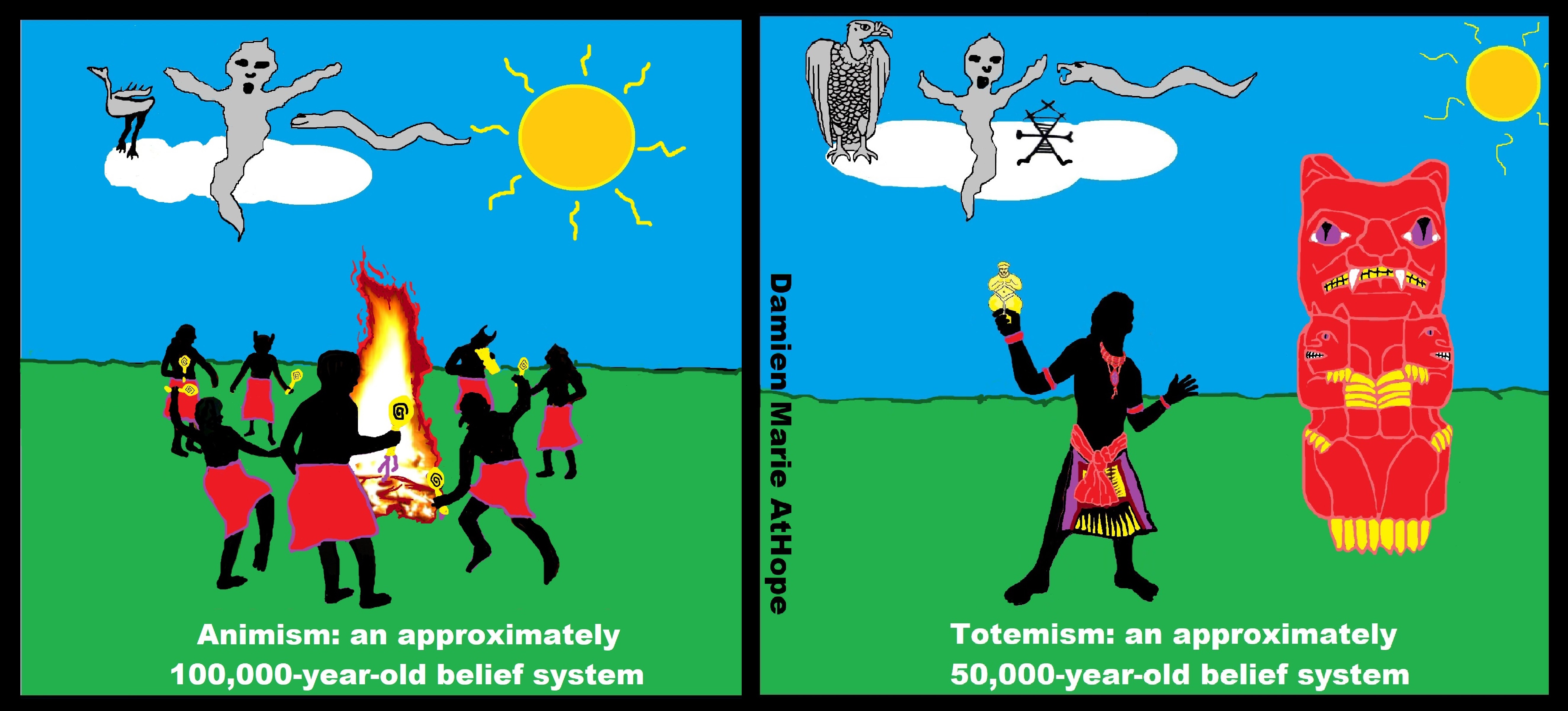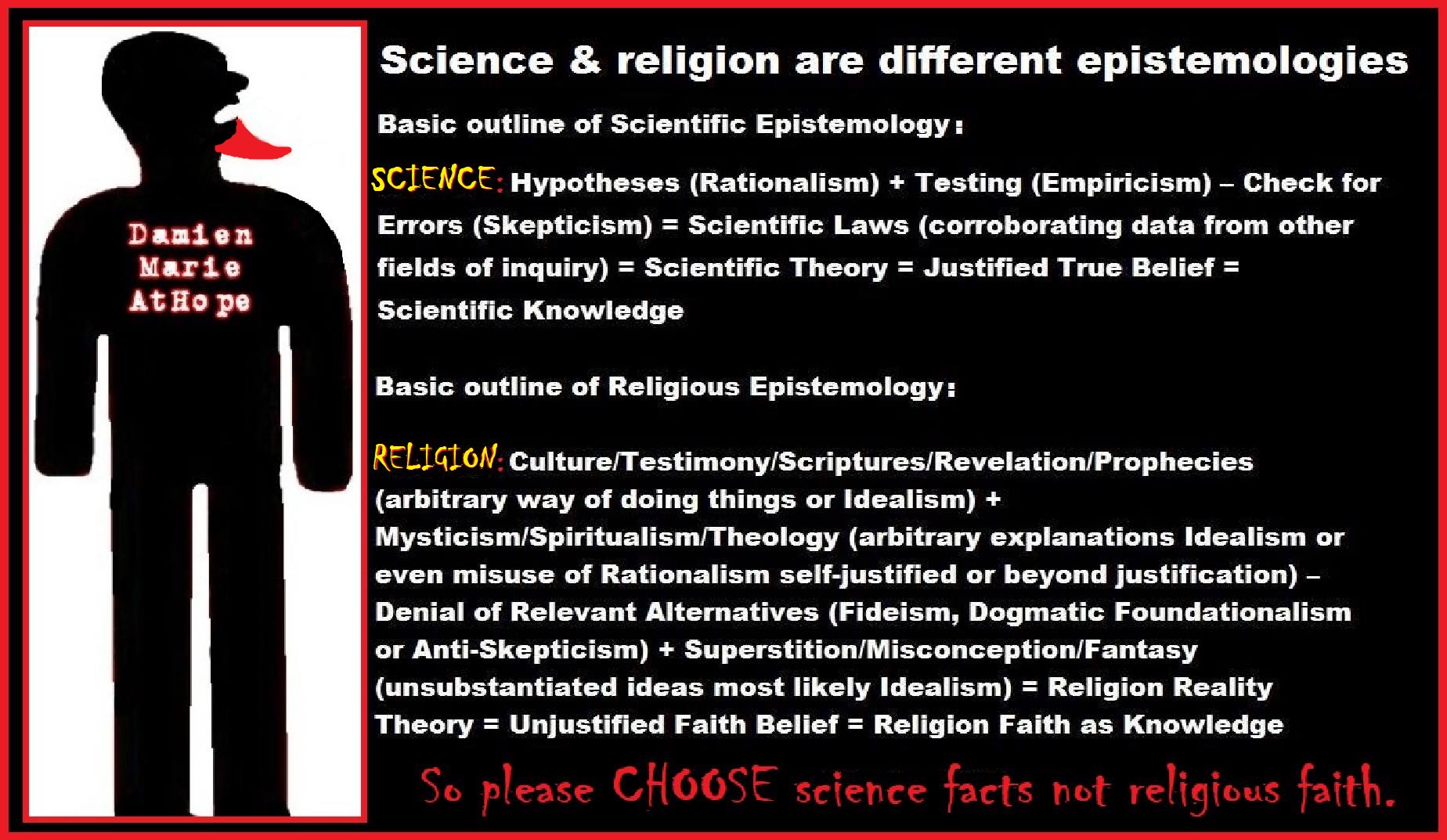The above picture is my art and I am going to explain some of its imagery.
My thoughts on religious progression, and reasoned speculations from the evidence:
Animism (100,000 years ago)
Totemism (50/45,000 years ago)
Shamanism (30/35,000 years ago)
Paganism (13/12,000 years ago)
“Institutional” Progressed Organized Religion (5,000 years ago)
Religion Progression
- Animism (belief in a perceived spirit world) passably by at least 100,000 years ago “the primal stage of early religion”
- Totemism (belief that these perceived spirits could be managed with created physical expressions) passably by at least 50,000 years ago “progressed stage of early religion”
- Shamanism (belief that some special person can commune with these perceived spirits on the behalf of others by way rituals) passably by at least 30,000 years ago
- Paganism “Early organized nature-based religion” mainly like an evolved shamanism with gods (passable by at least 13,000 years ago).
- Institutional religion developed stage of “Progressed Organized Type Religion” passably by at least 5,000 years ago as a social institution with official dogma usually set in a hierarchical/bureaucratic structure that contains strict rules and practices dominating the believer’s life.
- First, there is the foundation: Superstitionism and Symbolism/Ritualism.
- Second, is the frame and walls: Supernaturalism and Sacralizism/Spiritualism.
- Third, is the roof and finishing elements of the structure: Dogmatism and Myths.
- Fourth, is the window dressing and stylings to the house: decorated with the webs religious Dogmatic-Propaganda.
In the stage of organized religion, one important aspect that is often overlooked because of male-only thinking or by some over-emphasized because of extreme feminism is gender. There are some obvious gender associations in artifacts and possible gender-involved religious beliefs but thoughtful feminist archaeologists do not pounce on every representation of a woman and pronounce that it is a goddess. Around 5,000 years ago there are the full elements seem to be grouping together with its connected set of Dogmatic-Propaganda-Closure belief strains of sacralized superstitionism that took different forms of behavior in different areas of the world.
Interconnectedness of religious thinking Animism, Totemism, Shamanism, and Paganism
So, it all starts in a general way with Animism (theoretical belief in supernatural powers/spirits), then this is physically expressed in or with Totemism (theoretical belief in mythical relationship with powers/spirits through a totem item), which then enlists a full-time specific person to do this worship and believed interacting Shamanism (theoretical belief in access and influence with spirits through ritual), and then there is the further employment of myths and gods added to all the above giving you Paganism (often a lot more nature-based than most current top world religions, thus hinting to their close link to more ancient religious thinking it stems from). My hypothesis is expressed with an explanation of the building of a theatrical house (modern religions development ending with Institutional religion/organized religion).
Primal early superstition starts around 1 million years ago with. Then the development of religion increased around 600,000 years ago with proto superstition and then even to a greater extent around 300,000 years ago with progressed superstition. Around 100,000 years ago, is the primal stage of early religion, the proto stage of religion is around 75,000 years ago, or less, the progressed stage of early religion is around 50,000 years ago and finally after 13,500 years ago, begins with the evolution of organized religion. The set of stages for the development of organized religion is subdivided into the following: the primal stage of early organized religion is 13,000 years ago, the proto stage of organized religion is around 10,000 years ago, and finally the progressed stage of organized religion is around 7,000 years ago with the forming of mythology and its connected set of Dogmatic-Propaganda-Closure belief strains of sacralized superstitionism. In the stage of organized religion, one important aspect that is often overlooked because of male-only thinking or by some over-emphasized because of extreme feminism is gender. There are some obvious gender associations in artifacts and possible gender-involved religious beliefs but thoughtful feminist archaeologists do not pounce on every representation of a woman and pronounce that it is a goddess. Around 5,000 years ago elements seem to be grouping together with its connected set of Dogmatic-Propaganda-Closure belief strains of sacralized superstitionism that took different forms of behavior in different areas of the world.
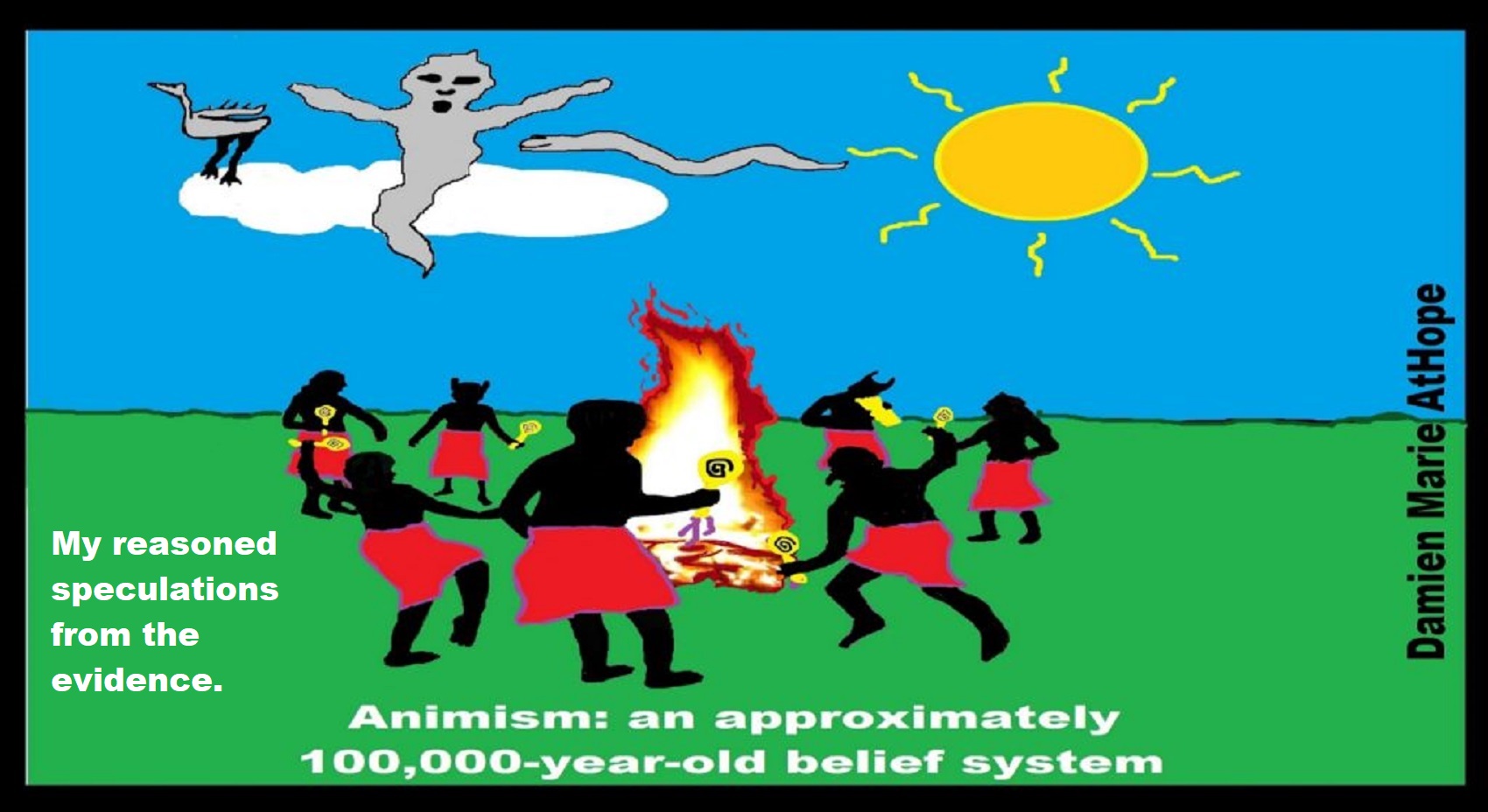
I classify Animism (animated ‘spirit‘ or “supernatural” perspectives).
I see all religious people as at least animists, so, all religions have at least some amount, kind, or expression of animism as well.
I want to make something clear as I can, as simple as I can, even though I classify Animism (animated and alive from Latin: anima, ‘breath, spirit, life‘ or peoples’ “spiritual” or “supernatural” perspectives. Potentially, in some animism perceives, all things may relate to some spiritual/supernatural/non-natural inclinations, even a possible belief that objects, places, and/or creatures all possess a distinct spiritual essence, and/or thinking things like all things—animals, plants, rocks, rivers, weather systems, human handiwork, and perhaps even words— could be as animated and alive ref) as the first expression of religious thinking or religion, it is not less than, nor is it not equal to any other religion, or religious thinking. I see all religious people as at least animists any way, so everyone is at least animist, how could it be less than other religions as all other religions have at least some amount, kind, or expression of animism. Animism, +? is what I think about all that say they are spiritual or religious in thinking. Regardless if they know it, understand it, or claim it, they all, to me, an animistic-thinker, plus a paganistic, totemistic, and shamanistic-monotheist, calling themselves a Christian, Jew, or Muslim, as an example of my thinking. Animism (is the other-then-reality thinking relates to, thus it is in all such non-reality thinking generally.
Furthermore, I actually am impressed by animist cultures in Africa, others have seen them as primitive or something, help with that, they are revolutionaries with women’s rights, child rights. I mean if I had to choose a religion it would be animism only like in Africa so I don’t look down on them nor any indigenous peoples, who I care about, as well as I am for “humanity for all.” I challenge religious Ideas, and this is not meant to be an attack on people, but rather a challenge to think or rethink ideas, I want what is actually true. May we all desire a truly honest search for what is true even if we have to update what we believe or know. I even have religious friends, as I am not a bigot.
I class religious thinking in “time of origin” not somehow that any are better or worse or more reasoned than others. No, I am trying to help others understand how things happened, so they understand, and for themselves can finally think does the religion they say they believe in, still seems true, as they believed before learning my information and art. I am hoping I inspire freedom of thought and development of heart as well as mind as we need such a holistic approach in our quest for a humanity free for all and supportive of all. Until then, train your brain to think ethically. We are responsible for the future, we are the future, living in the present, soon to be passed, so we must act with passion, because life is over just like that. I am just another fellow dignity being. May I be a good human.
To me, Animistic Somethingism: You just feel/think there has to be something supernatural/spirit-world or feel/think things are supernatural/spirit-filled. “Somethingism” is commonly an unspecified belief in an undetermined supernatural reality, stated sometimes as spiritual but not religious, but, to me, is basically unrealized animism. Vague Theism or god Somethingism: just say NO! May I remind you , vague theism, somethingism or “ietsism” is not some Philosophers Stone of Theism removed from strong critique.
“But Damien, Souls are real because energy does not die!”
My response, That is a logical fallacy as it is not a reasoned jump in logic. Energy leaves all once alive bodies by dissipating heat in the environment then is gone as the once related energy in a now dead body.
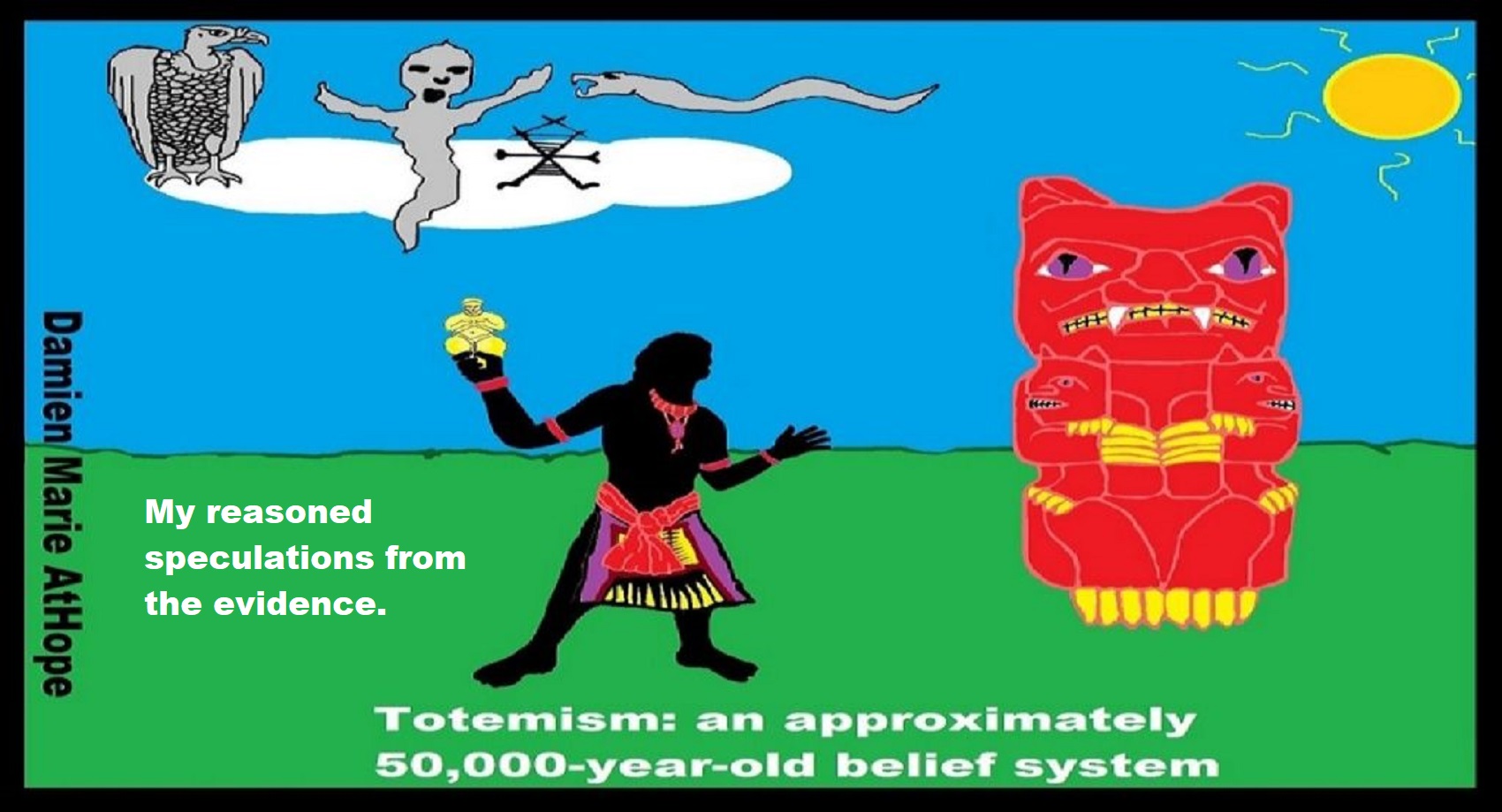
The idea and concept behind Totemism is that people have a spiritual connection or kinship with creatures or objects in nature, making the practice very similar to Animism. ref
* “animist” Believe in spirit-filled life and/or afterlife (you are a hidden animist/Animism : an approximately 100,000-year-old belief system Qafzeh: Oldest Intentional Burial of 15 individuals with red ocher and Border Cave: intentional burial of an infant with red ochre and a shell ornament (possibly extending to or from Did Neanderthals teach us “Primal Religion (Animism?)” 120,000 Years Ago, as they too used red ocher? well it seems to me it may be Neanderthals who may have transmitted a “Primal Religion (Animism?)” or at least burial and thoughts of an afterlife they seem to express what could be perceived as a Primal “type of” Religion, which could have come first is supported in how 250,000 years ago Neanderthals used red ochre and 230,000 years ago shows evidence of Neanderthal burial with grave goods and possibly a belief in the afterlife. Think the idea that Neanderthals who may have transmitted a “Primal Religion” as crazy then consider this, it appears that Neanderthals built mystery underground circles 175,000 years ago. Evidence suggests that the Neanderthals were the first humans to intentionally bury the dead, doing so in shallow graves along with stone tools and animal bones. Exemplary sites include Shanidar in Iraq, Kebara Cave in Israel and Krapina in Croatia. Or maybe Neanderthals had it transmitted to them Evidence of earliest burial: a 350,000-year-old pink stone axe with 27 Homo heidelbergensis. As well as the fact that the oldest Stone Age Art dates to around 500,000 to 233,000 Years Old and it could be of a female possibly with magical believed qualities or representing something that was believed to)
Here are a few of what I see as “Animist only” Cultures:
“Aka people” Central African nomadic Mbenga pygmy people. PRONUNCIATION: AH-kah
“The Aka people are very warm and hospitable. Relationships between men and women are extremely egalitarian. Men and women contribute equally to a household’s diet, either a husband or wife can initiate divorce, and violence against women is very rare. No cases of rape have been reported. The Aka people are fiercely egalitarian and independent. No individual has the right to force or order another individual to perform an activity against his or her will. Aka people have a number of informal methods for maintaining their egalitarianism. First, they practice “prestige avoidance”; no one draws attention to his or her own abilities. Individuals play down their achievements.” ref
“Mbuti People”
“The Mbuti people are generally hunter-gatherers who commonly are in the Congo’s Ituri Forest have traditionally lived in stateless communities with gift economies and largely egalitarian gender relations. They were a people who had found in the forest something that made life more than just worth living, something that made it, with all its hardships and problems and tragedies, a wonderful thing full of joy and happiness and free of care. Pygmies, like the Inuit, minimize discrimination based upon sex and age differences. Adults of all genders make communal decisions at public assemblies. The Mbuti people do not have a state, or chiefs or councils.” ref
“Hadza people”
“The Hadza people of Tanzania in East Africa are egalitarian, meaning there are no real status differences between individuals. While the elderly receive slightly more respect, within groups of age and sex all individuals are equal, and compared to strictly stratified societies, women are considered fairly equal. This egalitarianism results in high levels of freedom and self-dependency. When conflict does arise, it may be resolved by one of the parties voluntarily moving to another camp. Ernst Fehr and Urs Fischbacher point out that the Hadza people “exhibit a considerable amount of altruistic punishment” to organize these tribes. The Hadza people live in a communal setting and engage in cooperative child-rearing, where many individuals (both related and unrelated) provide high-quality care for children. Having no tribal or governing hierarchy, the Hadza people trace descent bilaterally (through paternal and maternal lines), and almost all Hadza people can trace some kin tie to all other Hadza people.” ref
Totemism is less holistic and somewhat masculine in nature compared to Animism with the heavily supported taboos and clan structure (things are separated and must stay separated with sacred and profane, off-limits and allowed, or clean and unclean running one’s entire lives. Things in nature are to be controlled or feared, things in nature have danger and can be evil, but it is also can be used for good and can be helpful for protection. There are spirits that I made thinner than Animism as it has to share space with the metaphorical clan ancestor there is also supernatural beings both animal and human-like Animism, but where animisms animals are calmer less harmful like the bird that is a stork referencing life, and the shake is smiling. Whereas, in totemism, this same template is changed through similar. The totemism bird is a vulture referencing a thing of death, not life, and the snake has its teeth barred as a threat. Like Animism, there are nonhuman supernatural things or being but in general would be attributed to a somewhat nonpersonal shared clan ancestor grandmother/grandfather or great grandmother/grandfather, not as much of what we think about like a god today.
“Totemism, system of belief in which humans are said to have kinship or a mystical relationship with a spirit-being, such as an animal or plant. The entity, or totem, is thought to interact with a given kin group or an individual and to serve as their emblem or symbol. The term totemism has been used to characterize a cluster of traits in the religion and in the social organization of many peoples. Totemism is manifested in various forms and types in different contexts and is most often found among populations whose traditional economies relied on hunting and gathering, mixed farming with hunting and gathering, or emphasized the raising of cattle. The term totem is derived from the Ojibwa word ototeman, meaning “one’s brother-sister kin.” The grammatical root, ote, signifies a blood relationship between brothers and sisters who have the same mother and who may not marry each other. In English, the word totem was introduced in 1791 by a British merchant and translator who gave it a false meaning in the belief that it designated the guardian spirit of an individual, who appeared in the form of an animal—an idea that the Ojibwa clans did indeed portray by their wearing of animal skins. It was reported at the end of the 18th century that the Ojibwa named their clans after those animals that live in the area in which they live and appear to be either friendly or fearful. The first accurate report about totemism in North America was written by a Methodist missionary, Peter Jones, himself an Ojibwa, who died in 1856 and whose report was published posthumously.” ref
“According to Jones, the Great Spirit had given toodaims(“totems”) to the Ojibwa clans, and because of this act, it should never be forgotten that members of the group are related to one another and on this account may not marry among themselves. Totemism is a complex of varied ideas and ways of behavior based on a worldview drawn from nature. There are ideological, mystical, emotional, reverential, and genealogical relationships of social groups or specific persons with animals or natural objects, the so-called totems. It is necessary to differentiate between group and individual totemism. These forms share some basic characteristics, but they occur with different emphases and in different specific forms. For instance, people generally view the totem as a companion, relative, protector, progenitor, or helper, ascribe to it superhuman powers and abilities, and offer it some combination of respect, veneration, awe, and fear. Most cultures use special names and emblems to refer to the totem, and those it sponsors engage in partial identification with the totem or symbolic assimilation to it. There is usually a prohibition or taboo against killing, eating, or touching the totem. Although totems are often the focus of ritual behavior, it is generally agreed that totemism is not a religion.” ref
“Totemism can certainly include religious elements in varying degrees, just as it can appear conjoined with magic. Totemism is frequently mixed with different kinds of other beliefs, such as ancestor worship, ideas of the soul, or animism. Such mixtures have historically made the understanding of particular totemistic forms difficult. Social or collective totemism is the most widely disseminated form of this belief system. It typically includes one or more of several features, such as the mystic association of animal and plant species, natural phenomena, or created objects with unilineally related groups (lineages, clans, tribes, moieties, phratries) or with local groups and families; the hereditary transmission of the totems (patrilineal or matrilineal); group and personal names that are based either directly or indirectly on the totem; the use of totemistic emblems and symbols; taboos and prohibitions that may apply to the species itself or can be limited to parts of animals and plants (partial taboos instead of partial totems); and a connection with a large number of animals and natural objects (multiplex totems) within which a distinction can be made between principal totems and subsidiary ones (linked totems). Group totems are generally associated or coordinated on the basis of analogies or on the basis of myth or ritual.” ref
“Just why particular animals or natural things—which sometimes possess no economic worth for the communities concerned—were originally selected as totems is often based on eventful and decisive moments in a people’s past. Folk traditions regarding the nature of totems and the origin of the societies in question are informative, especially with regard to the group’s cultural presuppositions. For example, a group that holds that it is derived directly or indirectly from a given totem may have a tradition in which its progenitor was an animal or plant that could also appear as a human being. In such belief systems, groups of people and species of animals and plants can thus have progenitors in common. In other cases, there are traditions that the human progenitor of a kin group had certain favorable or unfavorable experiences with an animal or natural object and then ordered that his descendants respect the whole species of that animal. Group totemism was traditionally common among peoples in Africa, India, Oceania (especially in Melanesia), North America, and parts of South America. These peoples include, among others, the Australian Aborigines, the African Pygmies, and various Native American peoples—most notably the Northwest Coast Indians (predominantly fishermen), California Indians, and Northeast Indians.” ref
“Moreover, group totemism is represented in a distinctive form among the Ugrians and west Siberians (hunters and fishermen who also breed reindeer) as well as among tribes of herdsmen in north and Central Asia. Individual totemism is expressed in an intimate relationship of friendship and protection between a person and a particular animal or a natural object (sometimes between a person and a species of animal); the natural object can grant special power to its owner. Frequently connected with individual totemism are definite ideas about the human soul (or souls) and conceptions derived from them, such as the idea of an alter ego and nagualism—from the Spanish form of the Aztec word naualli, “something hidden or veiled”—which means that a kind of simultaneous existence is assumed between an animal or a natural object and a person; i.e., a mutual, close bond of life and fate exists in such a way that in case of the injury, sickness, or death of one partner, the same fate would befall the other member of the relationship. Consequently, such totems became most strongly tabooed; above all, they were connected with family or group leaders, chiefs, medicine men, shamans, and other socially significant persons. Studies of shamanism indicate that individual totemism may have predated group totemism, as a group’s protective spirits were sometimes derived from the totems of specific individuals. To some extent, there also exists a tendency to pass on an individual totem as hereditary or to make taboo the entire species of animal to which the individual totem belongs.” ref
“Individual totemism is widely disseminated. It is found not only among tribes of hunters and harvesters but also among farmers and herdsmen. Individual totemism is especially emphasized among the Australian Aborigines and the American Indians. Among the Wiradjuri, an Aboriginal people who traditionally lived in New South Wales (Australia), totem clans are divided among two subgroups and corresponding matrilineal moieties. The group totem, named “flesh,” is transmitted from the mother. In contrast to this, individual totems belong only to the medicine men and are passed on patrilineally, also known as the male line. Such an individual totem is named bala, “spirit companion,” or jarawaijewa, “the meat (totem) that is within him.” There is a strict prohibition against eating the totem. Breach of the taboo carries with it sickness or death. It is said: “To eat your jarawaijewa is the same as if you were to eat your very own flesh or that of your father.” The medicine man identifies himself with his personal totem.” ref
“Every offense or injury against the totem has its automatic effect upon the man who commits it. It is a duty of the totem to guard the ritualist and the medicine man while he is asleep. In the case of danger or the arrival of strangers, the animal goes back into the body of the medicine man and informs him. After the death of the medicine man, the animal stands watch as a bright flickering light near the grave. The individual totem is also a helper of the medicine man. The medicine man emits the totem in his sleep or in a trance so that it can collect information for him. In this tradition, sorcery may also be practiced by the medicine man. By singing, for instance, the medicine man can send out his totem to kill an enemy; the totem enters the chest of the enemy and devours his viscera. The transmission of the individual totem to novices is done through the father or the grandfather, who, of course, himself is also a medicine man. While the candidate lies on his back, the totem is “sung into” him. The blood relative who is transmitting the totem takes a small animal and places it on the chest of the youngster. During the singing, the animal supposedly sinks slowly into his body and finally disappears into it. The candidate is then instructed on how he has to treat the animal that is his comrade, and he is further instructed in song and the ritual concentration that is necessary to dispatch the totem from his body.” ref
“Among the Nor-Papua of New Guinea, patrilineal, exogamous groups (consanguineous sibs) are spread over several villages and are associated with animals, especially fish. They believe that they are born from totems, and they make them taboo. Children are given an opportunity to decide during their initiation whether they will respect the paternal or maternal totem. Each group of relatives has a holy place to which the totem animal brings the souls of the dead and from which the souls of children are also believed to come. Totem animals are represented in various manifestations: as spirit creatures in sacred flutes, in disguises, and in figures preserved in each man’s house. At the end of initiation ceremonies, the totems are mimicked by the members of the group. Among the Iban of Sarawak (Malaysia), individual totemism has been the tradition. Particular persons dream of a spirit of an ancestor or a dead relative; this spirit appears in a human form, presents himself as a helper and protector, and names an animal (or sometimes an object) in which he is manifested. The Iban then observe the mannerisms of animals and recognize in the behavior of the animals the embodiment of their protector spirit (ngarong). Sometimes, members of the tribe also carry with them a part of such an animal. Not only this particular animal, but the whole species, is given due respect. Meals and blood offerings are also presented to the spirit animal.” ref
“Young men who wish to obtain such a protector spirit for themselves sleep on the graves of prominent persons or seek out solitude and fast so that they may dream of a helper spirit. Actually, only a few persons can name such animals as their very own. Individuals with protector spirits have also attempted to require from their descendants the respect and the taboo given the animal representing the spirit. As a rule, such descendants do not expect special help from the protector spirit, but they observe the totemistic regulations anyway. The Birhor, a people that were traditionally residents of the jungle of Chotanagpur Plateau in the northeast Deccan (India), are organized into patrilineal, exogamous totem groups. According to one imperfect list of 37 clans, 12 are based on animals, 10 on plants, 8 on Hindu castes and localities, and the rest on objects. The totems are passed on within the group, and tales about the tribe’s origins suggest that each totem had a fortuitous connection with the birth of the ancestor of the clan. The Birhor think that there is a temperamental or physical similarity between the members of the clan and their totems. Prohibitions or taboos are sometimes cultivated to an extreme degree. In regard to eating, killing, or destroying them, the clan totems are regarded as if they were human members of the group. Moreover, it is believed that an offense against the totems through a breach of taboo will produce a corresponding decrease in the size of the clan. If a person comes upon a dead totem animal, he must smear his forehead with oil or a red dye, but he must not actually mourn over the animal; he also does not bury it. The close and vital relationship between the totem and the clan is shown in a definite ceremony: the yearly offering to the chief spirit of the ancestral hill. Each Birhor community has a tradition of an old settlement that is thought to be located on a hill in the area. Once a year, the men of each clan come together at an open place.” ref
“The elder of the clan functions as the priest who gives the offering. A diagram with four sections is drawn on the ground with rice flour. In one of these, the elder sits while gazing in the direction of the ancestral hill. The emblem of the particular totem is placed in one of the other sections of the diagram; depending on the circumstances, this emblem could be a flower, a piece of horn or skin, a wing, or a twig. This emblem represents the clan as a whole. If an animal is needed for such a ceremony, it is provided by the members of another clan who do not hold it as a totem. The Birhor show great fear of the spirits of the ancestral hill and avoid these places as far as possible. Among the Kpelle people of Liberia there is not only group totemism but also individual totemism. Both kinds of totems are referred to variously as “thing of possession,” “thing of birth,” or “thing of the back of men.” These phrases express the idea that the totem always accompanies, belongs to, and stands behind one as a guide and warner of dangers. The totem also punishes the breach of any taboo. Kpelle totems include animals, plants, and natural phenomena.” ref
“The kin groups that live in several villages were matrilineal at an earlier time, but during the 20th century they began to exhibit patrilineal tendencies. The group totems, especially the animal totems, are considered as the residence of the ancestors; they are respected and are given offerings. Moreover, a great role is played by individual totems that, in addition to being taboo, are also given offerings. Personal totems that are animals can be transmitted from father to son or from mother to daughter; on the other hand, individual plant totems are assigned at birth or later. The totem also communicates magical powers. It is even believed possible to alter one’s own totem animal; further, it is considered an alter ego. Persons with the same individual totem prefer to be united in communities. The well-known leopard confederation, a secret association, seems to have grown out of such desires. Entirely different groups produce patrilineal taboo communities that are supposedly related by blood; they comprise persons of several tribes. The animals, plants, and actions made taboo by these groups are not considered as totems. In a certain respect, the individual totems in this community seem to be the basis of group totemism.” ref
* “totemist” Believe in spirit-filled life and/or afterlife can be attached to or be expressed in things or objects (you are a hidden totemist/Totemism: an approximately 50,000-year-old belief system (though it may be older as there is evidence of what looks like a Stone Snake in South Africa which may be the “first human worship” dating to around 70,000 years ago) (possibly extending to or from Neanderthals Likewise a number of archeologists propose that Middle Paleolithic societies — such as that of the Neanderthals — may also have practiced the earliest form of totemism or animal worship in addition to their (presumably religious) burial of the dead. Emil Bächler in particular suggests (based on archeological evidence from Middle Paleolithic caves) that a widespread Neanderthal bear-cultexisted. Animal cults in the following Upper Paleolithic period — such as the bear cult — may have had their origins in these hypothetical Middle Paleolithic animal cults. Animal worship during the Upper Paleolithic intertwined with hunting rites. For instance, archeological evidence from art and bear remains reveals that the bear cult apparently had involved a type of sacrificial bear ceremonialism in which a bear was shot with arrowsand then was finished off by a shot in the lungs and ritualistically buried near a clay bear statue covered by a bear fur, with the skull and the body of the bear buried separately. 100,000 to 50,000 years ago – Increased use of red ochre at several Middle Stone Age sites in Africa. Red Ochre is thought to have played an important role in ritual. 42,000 years ago – Ritual burial of a man at Lake Mungo in Australia. The body is sprinkled with copious amounts of red ochre. 40,000 years ago – Upper Paleolithic begins in Europe. An abundance of fossil evidence includes elaborate burials of the dead, Venus figurines (depiction of female) and cave art also involving red ochre. Aurignacian figurines have been found depicting faunal representations of the time period associated with now-extinct mammals, including mammoths, rhinoceros, and Tarpan, along with anthropomorphized depictions that may be interpreted as some of the earliest evidence of religion. Many 35,000-year-old animal figurines were discovered in the Vogelherd Cave in Germany. One of the horses, amongst six tiny mammoth and horse ivory figures found previously at Vogelherd, was sculpted as skillfully as any piece found throughout the Upper Paleolithic. The production of ivory beads for body ornamentation was also important during the Aurignacian. There is a notable absence of painted caves, however, which begin to appear within the Solutrean. Venus figurines are thought to represent fertility. The cave paintings at Chauvet and Lascaux are believed to represent religious thought. The oldest cave art is found in the Cave of El Castillo in Spain, in early Aurignacian dated at around 40,000 years, the time when it is believed that homo sapiens migrated to Europe from Africa. The paintings are mainly of deer. The next oldest cave paintings are found in the Chauvet Cave in France, dating to around 37,000 to 33,500 years ago and the second from 31,000 to 28,000 years ago with most of the black drawings dating to the earlier period. Chauvet Cave appears to have been used by humans during two distinct periods: the Aurignacian and the Gravettian. Most of the artwork dates to the earlier, Aurignacian, era (30,000 to 32,000 years ago). The later Gravettian occupation, which occurred 25,000 to 27,000 years ago. The paintings feature a larger variety of wild animals, such as lions, panthers, bears and hyenas. It’s strange to think that these animals were roaming around France at that time. There are no examples of complete human figures in these cave paintings. ref, ref, ref, ref, ref
Ps. Progressed organized religion, to me, starts approximately 5,000-year-old belief system)
“Anthropomorphism is the attribution of human traits, emotions, or intentions to non-human entities. It is considered to be an innate tendency of human psychology. Personification is the related attribution of human form and characteristics to abstract concepts such as nations, emotions and natural forces like seasons and the weather. Both have ancient roots as storytelling and artistic devices, and most cultures have traditional fables with anthropomorphized animals as characters. People have also routinely attributed human emotions and behavioral traits to wild as well as domestic animals. From the beginnings of human behavioral modernity in the Upper Paleolithic, about 40,000 years ago, examples of zoomorphic (animal-shaped) works of art occur that may represent the earliest evidence we have of anthropomorphism. One of the oldest known is an ivory sculpture, the Löwenmensch figurine, Germany, a human-shaped figurine with the head of a lioness or lion, determined to be about 32,000 years old. It is not possible to say what these prehistoric artworks represent. A more recent example is The Sorcerer, an enigmatic cave painting from the Trois-Frères Cave, Ariège, France: the figure’s significance is unknown, but it is usually interpreted as some kind of great spirit or master of the animals. In either case, there is an element of anthropomorphism.” Ref
“This anthropomorphic art has been linked by archaeologist Steven Mithen with the emergence of more systematic hunting practices in the Upper Palaeolithic (Mithen 1998). He proposes that these are the product of a change in the architecture of the human mind, an increasing fluidity between the natural history and social intelligences, where anthropomorphism allowed hunters to identify empathetically with hunted animals and better predict their movements. The Upper Paleolithic (or Upper Palaeolithic, Late Stone Age) is the third and last subdivision of the Paleolithic or Old Stone Age. Very broadly, it dates to between 50,000 and 10,000 years ago (the beginning Holocene), roughly coinciding with the appearance of behavioral modernity and before the advent of agriculture. Anatomically modern humans (i.e. Homo sapiens) are believed to have emerged around 200,000 years ago, although these lifestyles changed very little from that of archaic humans of the Middle Paleolithic, until about 50,000 years ago, when there was a marked increase in the diversity of artifacts. This period coincides with the expansion of modern humans throughout Eurasia, which contributed to the extinction of the Neanderthals. The Upper Paleolithic has the earliest known evidence of organized settlements, in the form of campsites, some with storage pits. Artistic work blossomed, with cave painting, petroglyphs, carvings and engravings on bone or ivory.” Ref
“The first evidence of human fishing is also noted, from artifacts in places such as Blombos cave in South Africa. More complex social groupings emerged, supported by more varied and reliable food sources and specialized tool types. This probably contributed to increasing group identification or ethnicity. By 50,000–40,000 BP, the first humans set foot in Australia. By 45,000 BP, humans lived at 61° north latitude in Europe. By 30,000 BP, Japan was reached, and by 27,000 BP humans were present in Siberia above the Arctic Circle. At the end of the Upper Paleolithic, a group of humans crossed the Bering land bridge and quickly expanded throughout North and South America. Both Homo erectus and Neanderthals used the same crude stone tools. Archaeologist Richard G. Klein, who has worked extensively on ancient stone tools, describes the stone tool kit of archaic hominids as impossible to categorize. It was as if the Neanderthals made stone tools, and were not much concerned about their final forms. He argues that almost everywhere, whether Asia, Africa or Europe, before 50,000 years ago all the stone tools are much alike and unsophisticated. Firstly among the artifacts of Africa, archeologists found they could differentiate and classify those of less than 50,000 years into many different categories, such as projectile points, engraving tools, knife blades, and drilling and piercing tools. These new stone-tool types have been described as being distinctly differentiated from each other; each tool had a specific purpose. The invaders commonly referred to as the Cro-Magnons, left many sophisticated stone tools, carved and engraved pieces on bone, ivory and antler, cave paintings and Venus figurines.” Ref
“The Neanderthals continued to use Mousterian stone tool technology and possibly Chatelperronian technology. These tools disappeared from the archeological record at around the same time the Neanderthals themselves disappeared from the fossil record, about 40,000 years ago. Settlements were often located in narrow valley bottoms, possibly associated with the hunting of passing herds of animals. Some of them may have been occupied year round, though more commonly they appear to have been used seasonally; people moved between the sites to exploit different food sources at different times of the year. Hunting was important, and caribou/wild reindeer “may well be the species of single greatest importance in the entire anthropological literature on hunting.” Technological advances included significant developments in flint tool manufacturing, with industries based on fine blades rather than simpler and shorter flakes. Burins and racloirs were used to work bone, antler, and hides. Advanced darts and harpoons also appear in this period, along with the fish hook, the oil lamp, rope, and the eyed needle. The changes in human behavior have been attributed to the changes in climate during the period, which encompasses a number of global temperature drops. This meant a worsening of the already bitter climate of the last glacial period (popularly but incorrectly called the last ice age). Such changes may have reduced the supply of usable timber and forced people to look at other materials. In addition, flint becomes brittle at low temperatures and may not have functioned as a tool. Some scholars have argued that the appearance of complex or abstract language made these behavior changes possible.” Ref
“The complexity of the new human capabilities hints that humans were less capable of planning or foresight before 40,000 years, while the emergence of cooperative and coherent communication marked a new era of cultural development. In religion and mythology, anthropomorphism refers to the perception of a divine being or beings in human form or the recognition of human qualities in these beings. Ancient mythologies frequently represented the divine as deities with human forms and qualities. They resemble human beings not only in appearance and personality; they exhibited many human behaviors that were used to explain natural phenomena, creation, and historical events. The deities fell in love, married, had children, fought battles, wielded weapons, and rode horses and chariots. They feasted on special foods and sometimes required sacrifices of food, beverage, and sacred objects to be made by human beings. Some anthropomorphic deities represented specific human concepts, such as love, war, fertility, beauty, or the seasons. Anthropomorphic deities exhibited human qualities such as beauty, wisdom, and power, and sometimes human weaknesses such as greed, hatred, jealousy, and uncontrollable anger. Greek deities such as Zeus and Apollo often were depicted in human form exhibiting both commendable and despicable human traits. Anthropomorphism in this case is referred to as anthropotheism. From the perspective of adherents to religions in which humans were created in the form of the divine, the phenomenon may be considered theomorphism, or the giving of divine qualities to humans. Anthropomorphism has cropped up as a Christian heresy, particularly prominently with the Audians in third century Syria, but also in fourth-century Egypt and tenth century Italy. This often was based on a literal interpretation of Genesis 1:27: “So God created man in His own image, in the image of God created He him; male and female created He them.” Ref
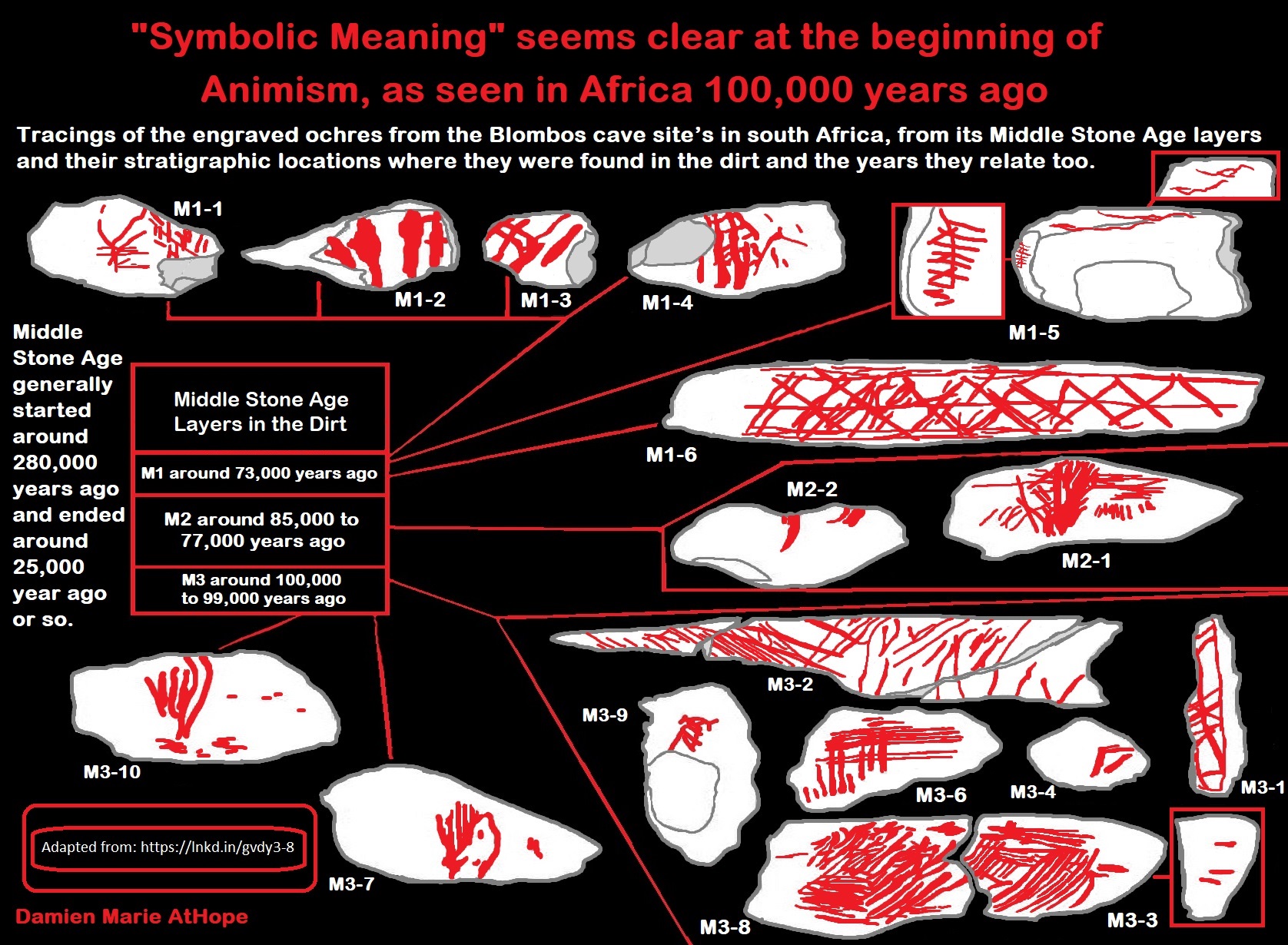
Adapted from: ref
Here we see the tracings of the engraved ochres from the Blombos cave site’s in South Africa, from its Middle Stone Age layers and their stratigraphic locations where they were found in the dirt and the years they relate to. M1 dates to around 73,000 years ago, M2 around 85,000 to 77,000 years ago, and M3 dates to around 100,000 to 99,000 years ago. Middle Stone Age generally started around 280,000 years ago and ended around 25,000 years ago or so. Therefore, amazing as it is, here we have proof that “Symbolic Meaning,” seems to be clear at the beginning of Animism, as seen in Africa 100,000 years ago. In a landmark study, it was demonstrated, for the first time, that there are seeming tradition in the production of geometric engraved representations, includes the production of a number of different patterns and this set of evolving traditions have roots that go back in time to at least 100,000 years ago (around a time I say Animism begins in Africa). The fact that they were created, that most of them are deliberate and were made with representational intent, strongly suggests they functioned as artifacts within a society by symbols with meaning. ref
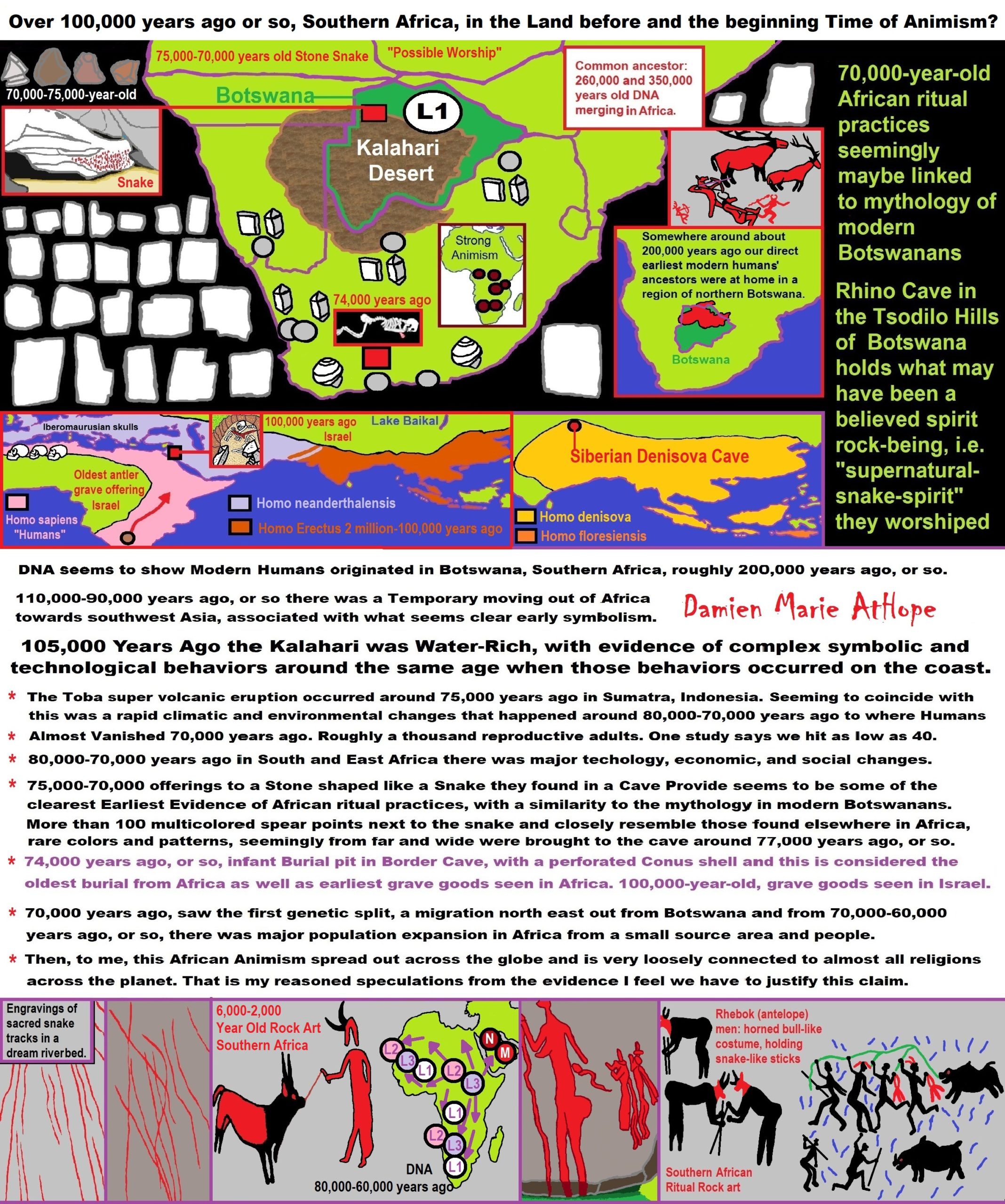
ref, ref, ref, ref, ref, ref, ref, ref, ref, ref, ref, ref, ref, ref, ref, ref, ref, ref, ref, ref, ref, ref, ref, ref, ref, ref, ref, ref, ref, ref, ref, ref, ref, ref, ref, ref, ref, ref, ref, ref, ref, ref, ref, ref, ref, ref, ref, ref, ref, ref, ref, ref
Animism: a belief among some indigenous people, young children, or all religious people!
Over 100,000 years ago or so, Southern Africa, in the Land before and the beginning Time of Animism: LINK
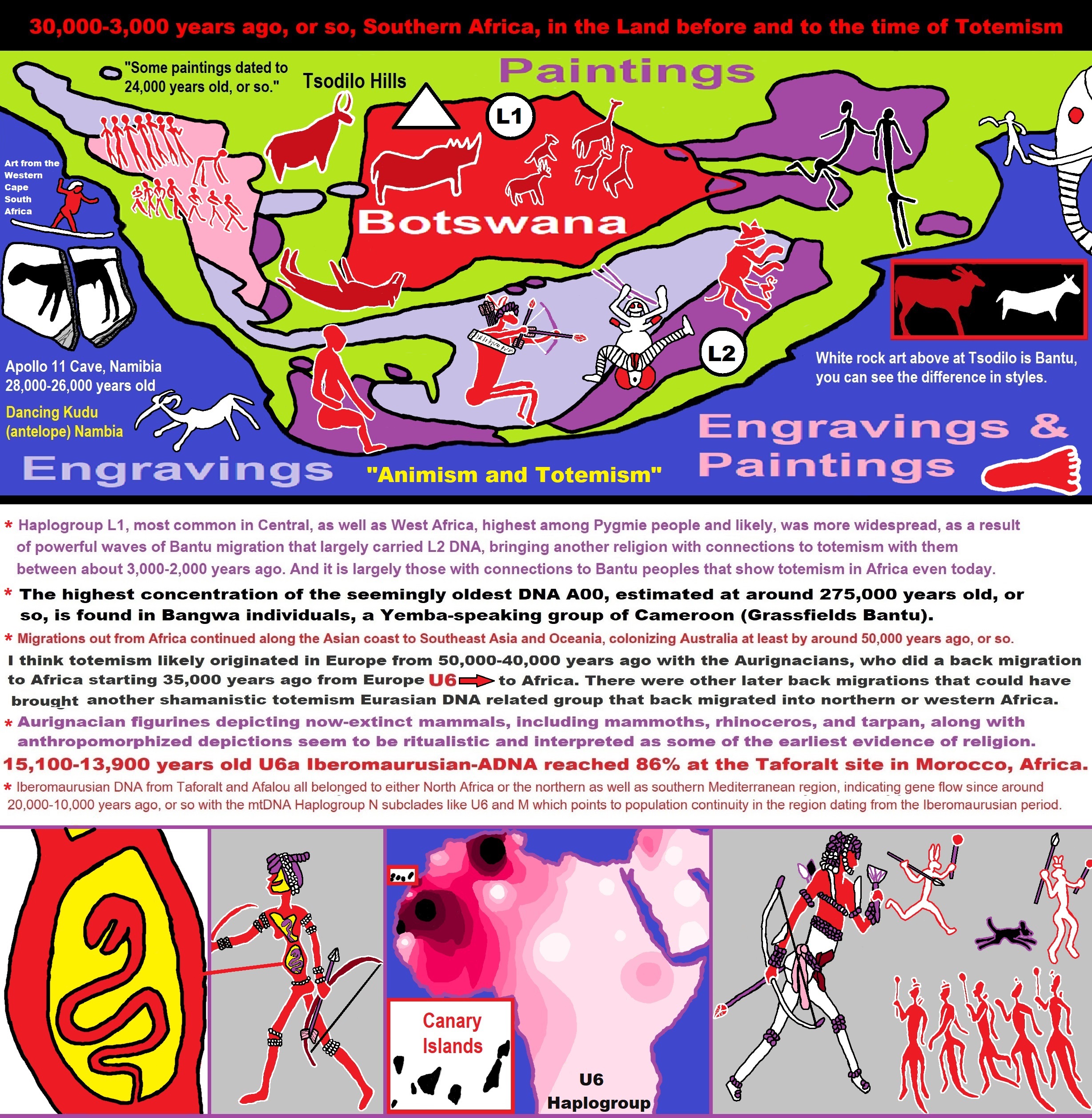
ref, ref, ref, ref, ref, ref, ref, ref, ref, ref, ref, ref, ref, ref, ref, ref, ref, ref, ref, ref, ref, ref, ref, ref, ref, ref, ref, ref, ref, ref, ref, ref, ref, ref, ref, ref, ref, ref, ref, ref, ref, ref, ref, ref, ref, ref, ref, ref, ref, ref, ref, ref, ref, ref, ref, ref, ref, ref, ref, ref,
Explaining the Earliest Religious Expression, that of Animism (beginning 100,000 to 70,000 years ago?) to Totemism (beginning 30,000 to 3,000 years ago?) in Southern Africa: LINK
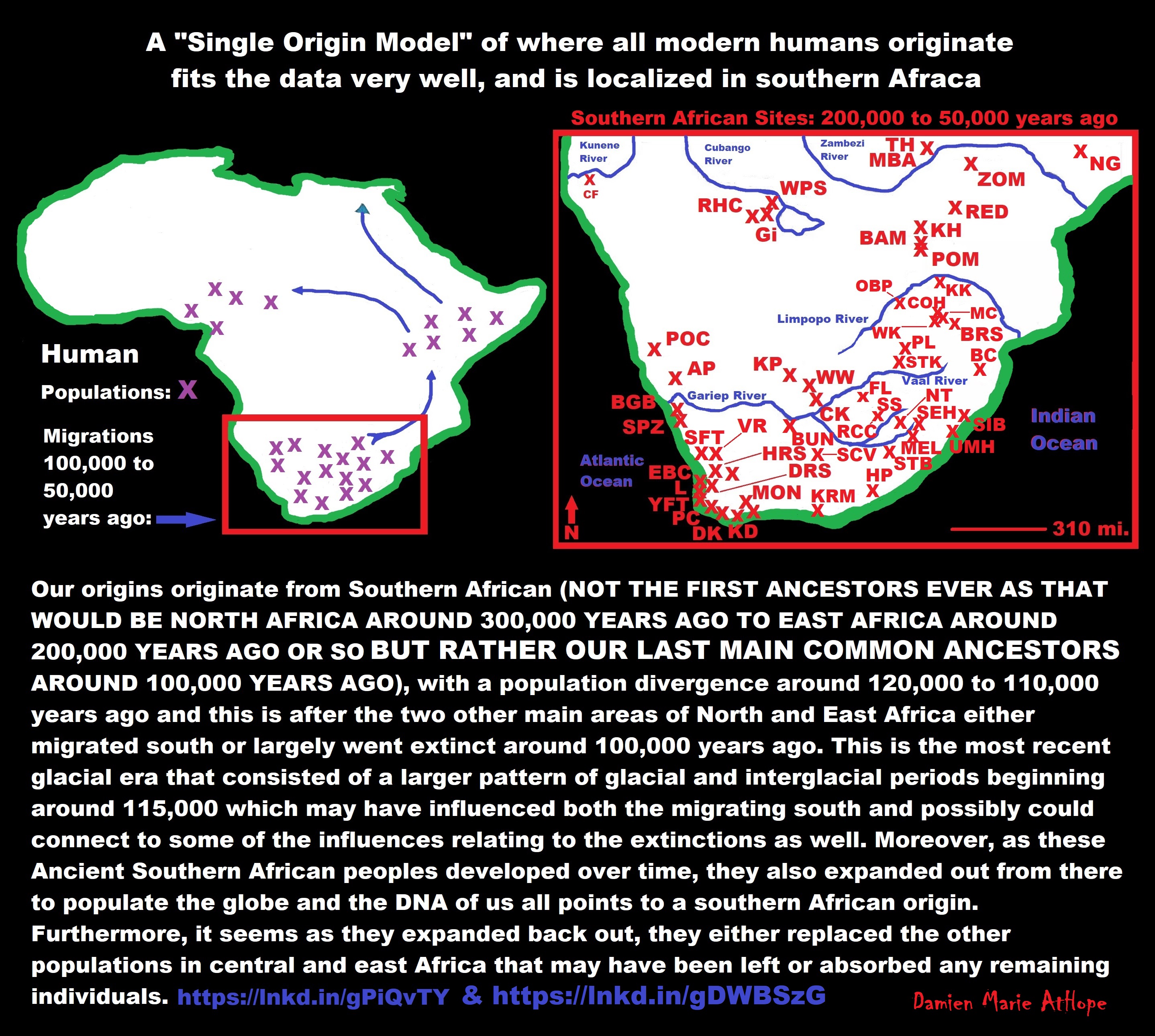
Our origins originate from Southern African (NOT THE FIRST ANCESTORS EVER AS THAT WOULD BE NORTH AFRICA AROUND 300,000 YEARS AGO TO EAST AFRICA AROUND 200,000 YEARS AGO OR SO BUT RATHER OUR LAST MAIN COMMON ANCESTORS AROUND 100,000 YEARS AGO), with a population divergence around 120,000 to 110,000 years ago and this is after the two other main areas of North and East Africa either migrated south or largely went extinct around 100,000 years ago. This is the most recent glacial era that consisted of a larger pattern of glacial and interglacial periods beginning around 115,000 which may have influenced both the migrating south and possibly could connect to some of the influences relating to the extinctions as well. Moreover, as these Ancient Southern African peoples developed over time, they also expanded out from there to populate the globe, and the DNA of us all points to a southern African origin. Furthermore, it seems as they expanded back out, they either replaced the other populations in central and east Africa that may have been left or absorbed any remaining individuals. ref
Southern African Middle Stone Age sites:
(Ap) Apollo 11; (BAM) Bambata; (BBC) Blombos Cave; (BC) Border Cave; (BGB)Boegoeberg; (BPA) Boomplaas; (BRS) Bushman Rock Shelter; (BUN) Bundu Farm; (CF)Cufema Reach; (CK) Canteen Kopje; (COH) Cave of Hearths; (CSB) Cape St Blaize; (DK)Die Kelders Cave 1; (DRS) Diepkloof Rock Shelter; (EBC) Elands Bay Cave; (FL) Florisbad; (≠GI) ≠Gi; (HP) Howiesons Poort; (HRS) Hollow Rock Shelter; (KD) Klipdrift; (KKH) Klein Kliphuis; (KH) Khami; (KK) Kudu Koppie; (KP) Kathu Pan; (KRM) Klasies River Main Site; (L) Langebaan; (MBA) Mumbwa Caves; (MC) Mwulu’s Cave; (MEL)Melikane; (MON) Montagu Cave; (NBC) Nelson Bay Cave; (NG) Ngalue; (NT) Ntloana Tšoana; (OBP) Olieboomspoort; (PC) Peers Cave; (POC) Pockenbank; (PL) Plover’s Lake; (POM) Pomongwe; (PP) Pinnacle Point; (RCC) Rose Cottage Cave; (RED) Redcliff; (RHC) Rhino Cave; (SCV) Seacow Valley; (SFT) Soutfontein; (SEH) Sehonghong; (SIB)Sibudu Cave; (SPZ) Spitzkloof Rock Shelter; (SS) Sunnyside 1; (STB) Strathalan Cave B; (STK) Sterkfontein; (TR) Twin Rivers; (UMH) Umhlatuzana; (VR) Varsche Rivier 003; (WPS) White Paintings Shelter; (WK) Wonderkrater; (WW) Wonderwerk; (YFT)Ysterfontein 1; (ZOM) Zombepata Cave. ref

At Border Cave, a “savanna-woodland” vegetation community is implied before 100,000 years ago and the matching density of stone tools vary considerably through time, with high frequencies of stone blades occurring before 100,000 years ago. ref
Around 74,000 years ago, in Border Cave, South Africa, the burial of a 4 to 6-month-old child was found in a pit with a personal ornament, a perforated Conus shell. ref
Border Cave is the only African site covering a time span of 250,000 years, with Middle Stone Age human remains, and also records the first emergence of key cultural innovations such as things like grass bedding dated between 70,000 to 30,000 years ago. ref
In South Africa, some of the oldest beads are made of marine shells that come from the Still Bay layers of Blombos Cave dating back to around 72,000 years ago, and engraved ostrich eggshells dated to around 60,000 years ago from Diepkloof in South Africa. Some of the oldest beads made of non-marine shells involve ostrich eggshells and from Border Cave, there are some that date to around 42,000 years ago. Beads were also collected from the late MSA/early LSA context of similar age at Apollo 11 and from layers associated with MSA at Boomplaas Cave. Furthermore, beads were also reported from the MSA at Cave of Hearths. Other sub-contemporaneous beads have been recovered north of South Africa. ref
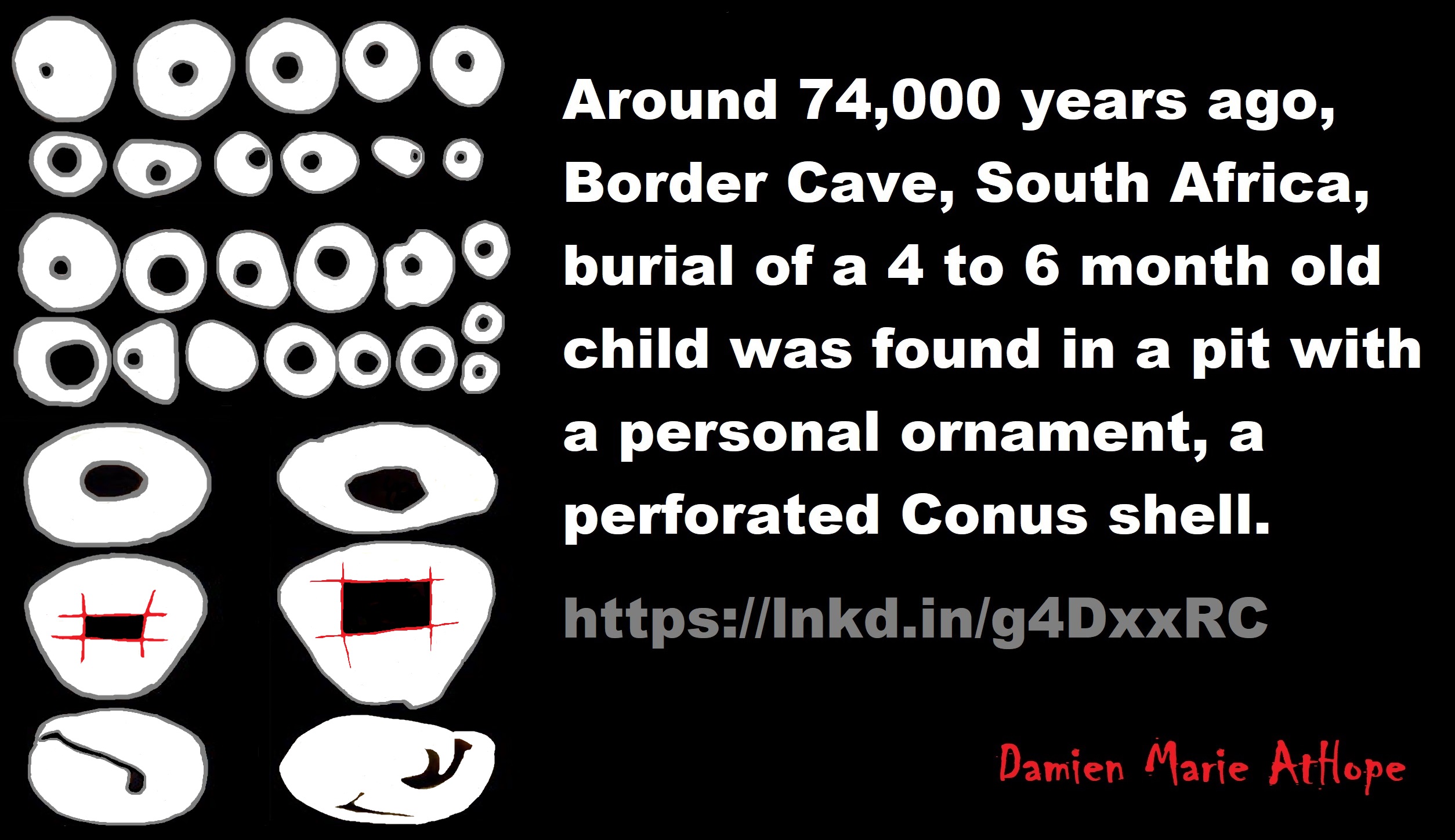
Around 74,000 years ago, Border Cave, South Africa, burial of a 4 to 6 month old child was found in a oval pit with a personal ornament, a perforated Conus shell. ref

Stone Snake of South Africa: “first human worship” 70,000 years ago
Evidence from Rhino Cave, in Botswana produced results that revealed a very special set of behavioral patterns which best-fit ritualized behavior. There were colorful non-local stone tools carefully and often elaborately made just to be offered to the stone snake; burned and smashed beyond use then abandoned. ref
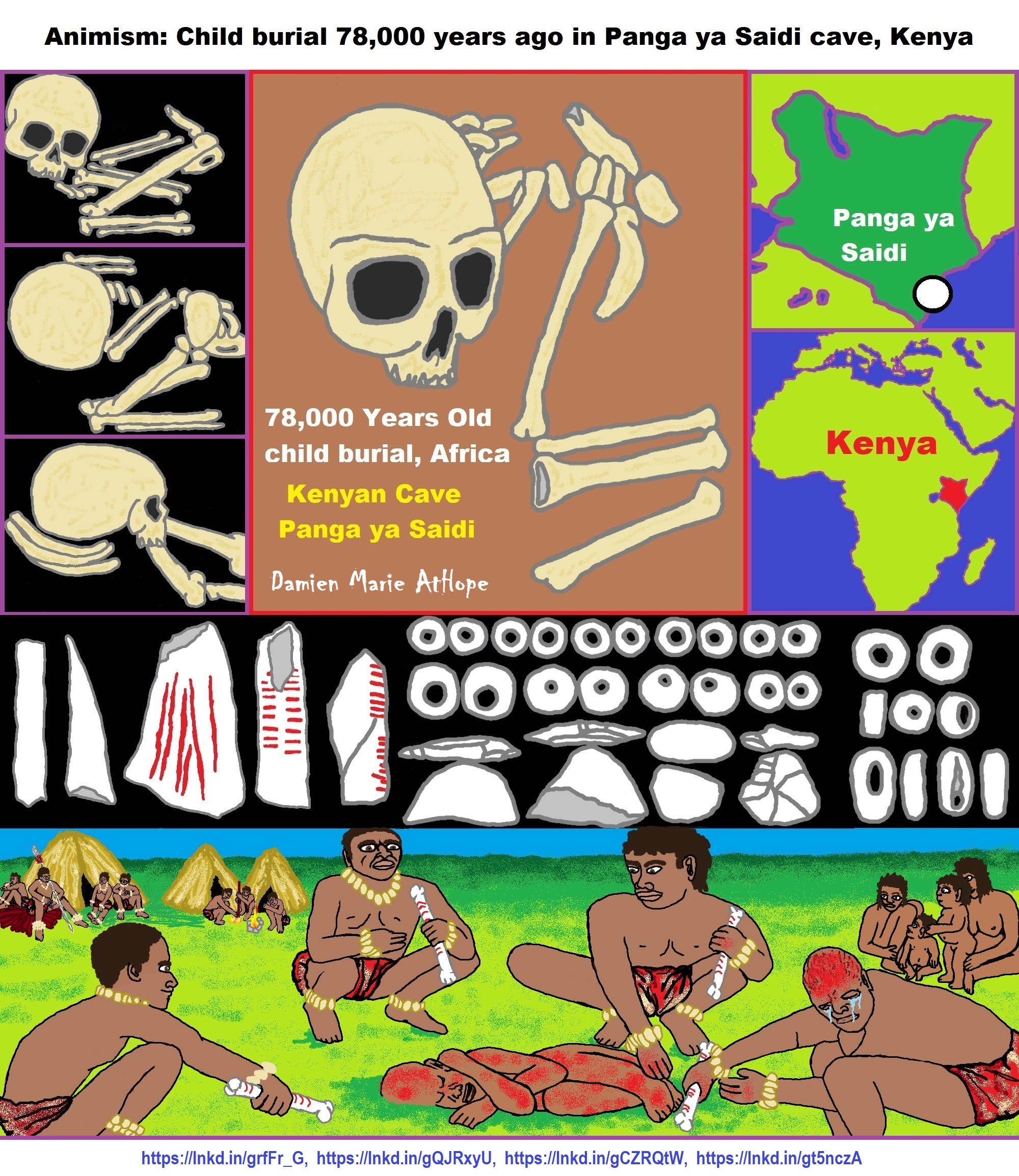
“Mtoto’s burial, to experts it is believed the child was around three years old when they died and was likely wrapped in a shroud and had their head on a pillow. Besides the seemingly deliberate position of the body, the team noticed a few clues that suggested the child was swaddled in cloth, possibly with the intention of preserving the corpse. They also speculate the body was placed in a cave fissure — known as funerary caching — before being covered with sediment.” ref, ref

“When researchers completed the final analysis of the Human Genome Project in April 2003, they confirmed that the 3 billion base pairs of genetic letters in humans were 99.9 percent identical in every person. It also meant that individuals are, on average, 0.1 percent different genetically from every other person on the planet. And in that 0.1 percent lies the mystery of why some people are more susceptible to a particular illness or more likely to be healthy than their neighbor – or even another family member.” ref

ref, ref, ref, ref, ref, ref, ref, ref, ref, ref, ref, ref
“There were at least several “out-of-Africa” dispersals of modern humans, possibly beginning as early as 270,000 years ago, including 215,000 years ago to at least Greece, and certainly via northern Africa and the Arabian Peninsula about 130,000 to 115,000 years ago. These early waves appear to have mostly died out or retreated by 80,000 years ago.” ref
“The most significant “recent” wave out of Africa took place about 70,000–50,000 years ago, via the so-called “Southern Route“, spreading rapidly along the coast of Asia and reaching Australia by around 65,000–50,000 years ago, (though some researchers question the earlier Australian dates and place the arrival of humans there at 50,000 years ago at earliest, while others have suggested that these first settlers of Australia may represent an older wave before the more significant out of Africa migration and thus not necessarily be ancestral to the region’s later inhabitants) while Europe was populated by an early offshoot which settled the Near East and Europe less than 55,000 years ago.” ref
- “An Eastward Dispersal from Northeast Africa to Arabia 150,000–130,000 years ago based on the finds at Jebel Faya dated to 127,000 years ago (discovered in 2011). Possibly related to this wave are the finds from Zhirendong cave, Southern China, dated to more than 100,000 years ago. Other evidence of modern human presence in China has been dated to 80,000 years ago.” ref
- “The most significant out of Africa dispersal took place around 50–70,000 years ago via the so-called Southern Route, either before or after the Toba event, which happened between 69,000 and 77,000 years ago. This dispersal followed the southern coastline of Asia, and reached Australia around 65,000-50,000 years ago, or according to some research, by 50,000 years ago at earliest. Western Asia was “re-occupied” by a different derivation from this wave around 50,000 years ago, and Europe was populated from Western Asia beginning around 43,000 years ago.” ref
- “Wells (2003) describes an additional wave of migration after the southern coastal route, namely a northern migration into Europe at circa 45,000 years ago. However, this possibility is ruled out by Macaulay et al. (2005) and Posth et al. (2016), who argue for a single coastal dispersal, with an early offshoot into Europe.” ref

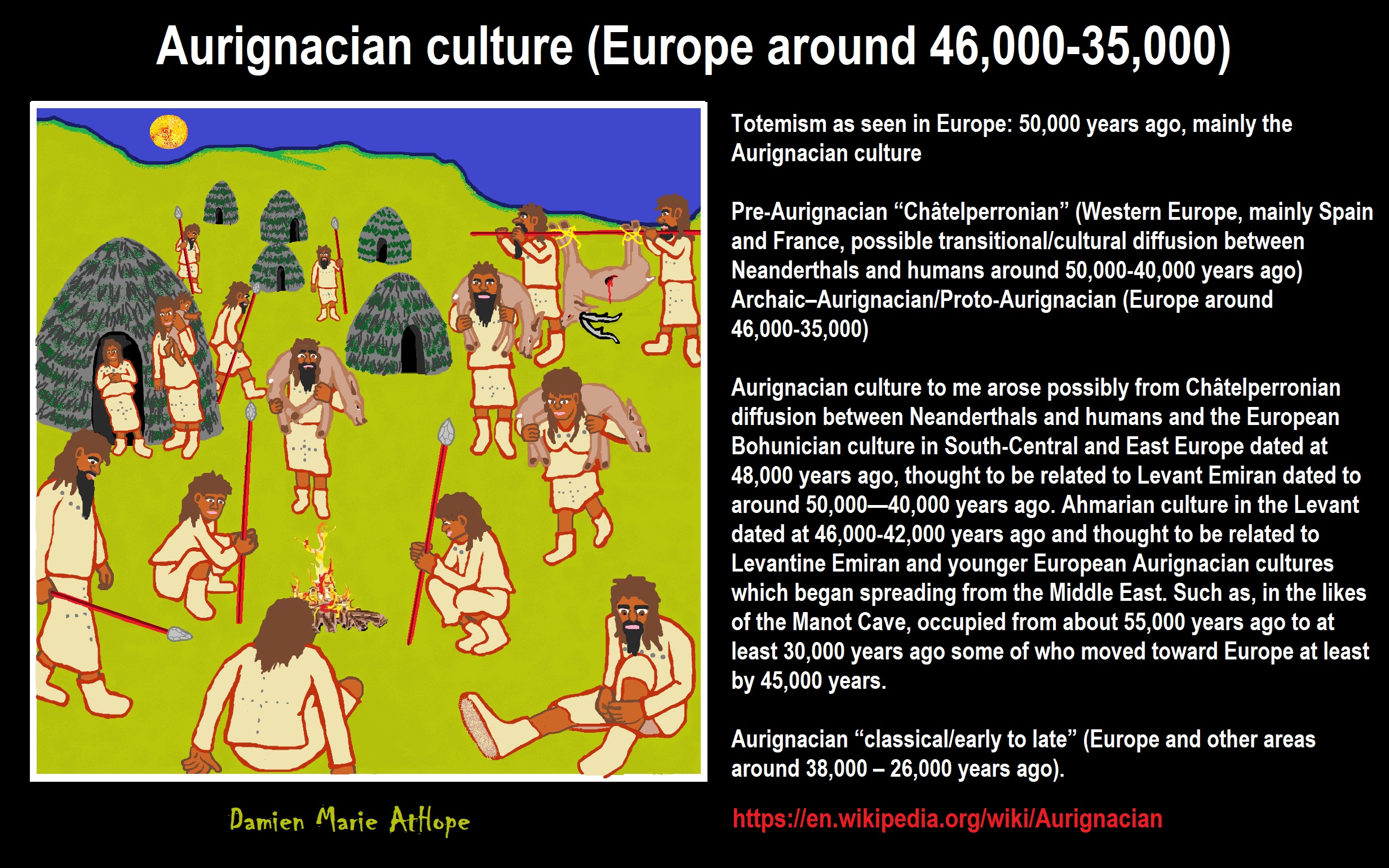

In Kostënki 17, Russia, there were numerous pendants recovered and at least one, seen above, was dated to 43,000 years ago, which was made from fossil belemite rostrum. The artifacts include a group of more than 40 pendants made from fox canines teeth. In addition, there were pendants made from stone and fossils as well. Along with shell beads from the lower layers of Kostënki 14 and the Kostënki 17 pendants are the earliest good evidence for personal adornment anywhere in Eastern Europe. The occupations at Kostenki include several Late Early Upper Paleolithic levels, dated between 42,000 to 30,000 calibrated years ago (cal BP). Kostenki, the Aurignacian sequence was considered the oldest component associated with modern humans at archaeological sites in Europe, underlain by Mousterian-like deposits representing Neanderthals. Kostenki 14, also known as Markina Gora, is the main site at Kostenki, and it has been found to contain genetic evidence concerning the migration of early modern humans from Africa into Eurasia. ref, ref
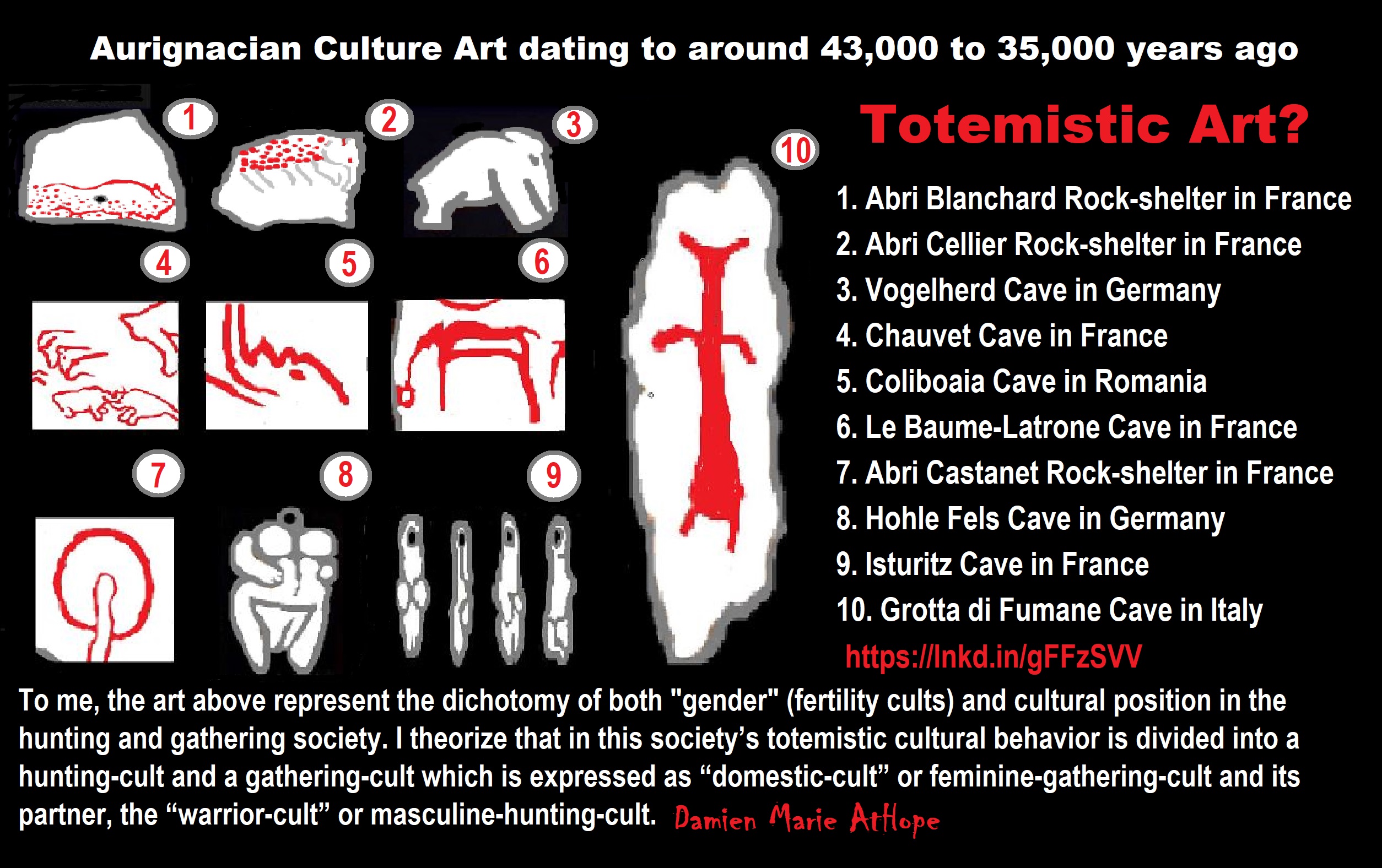
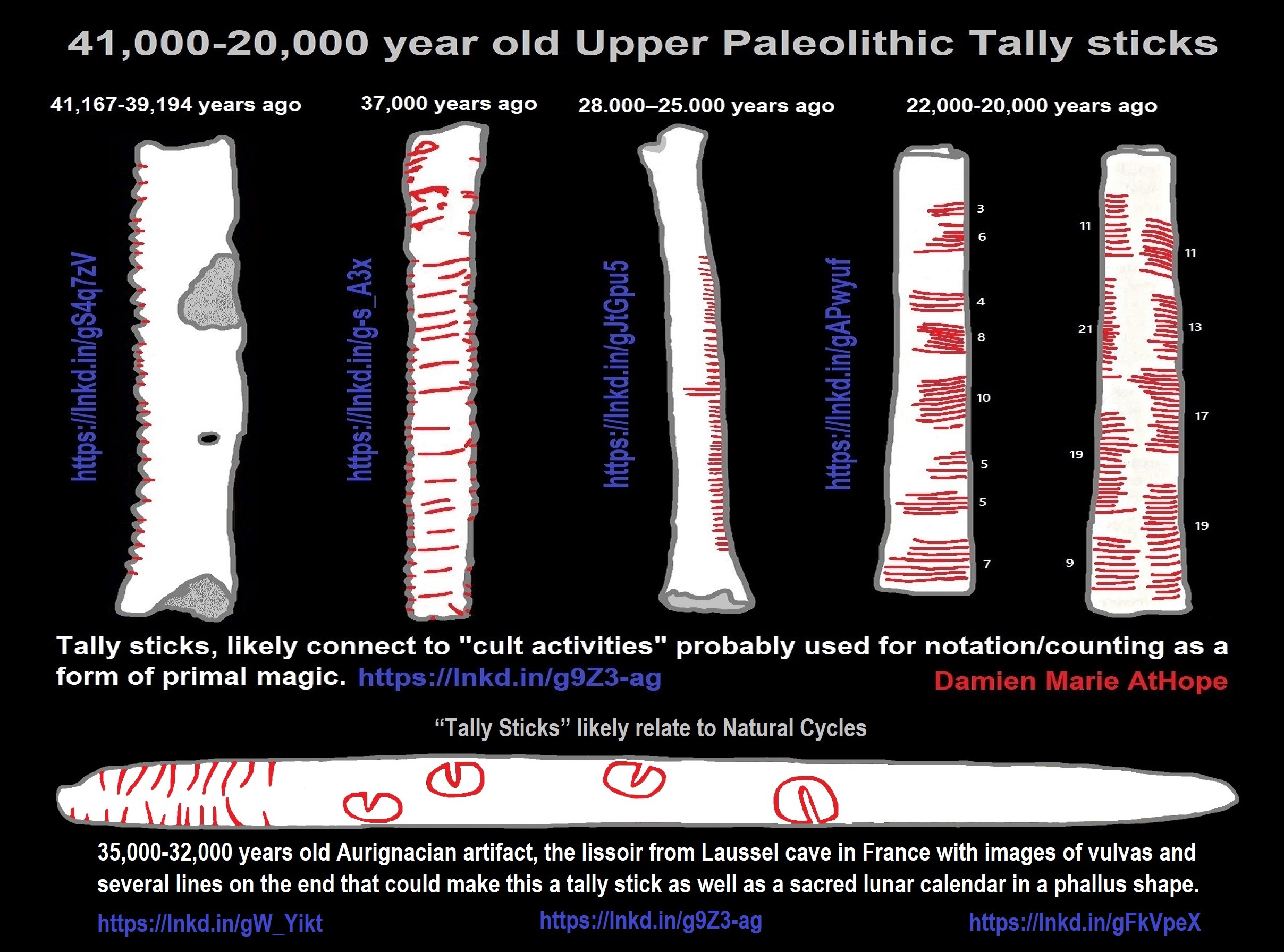


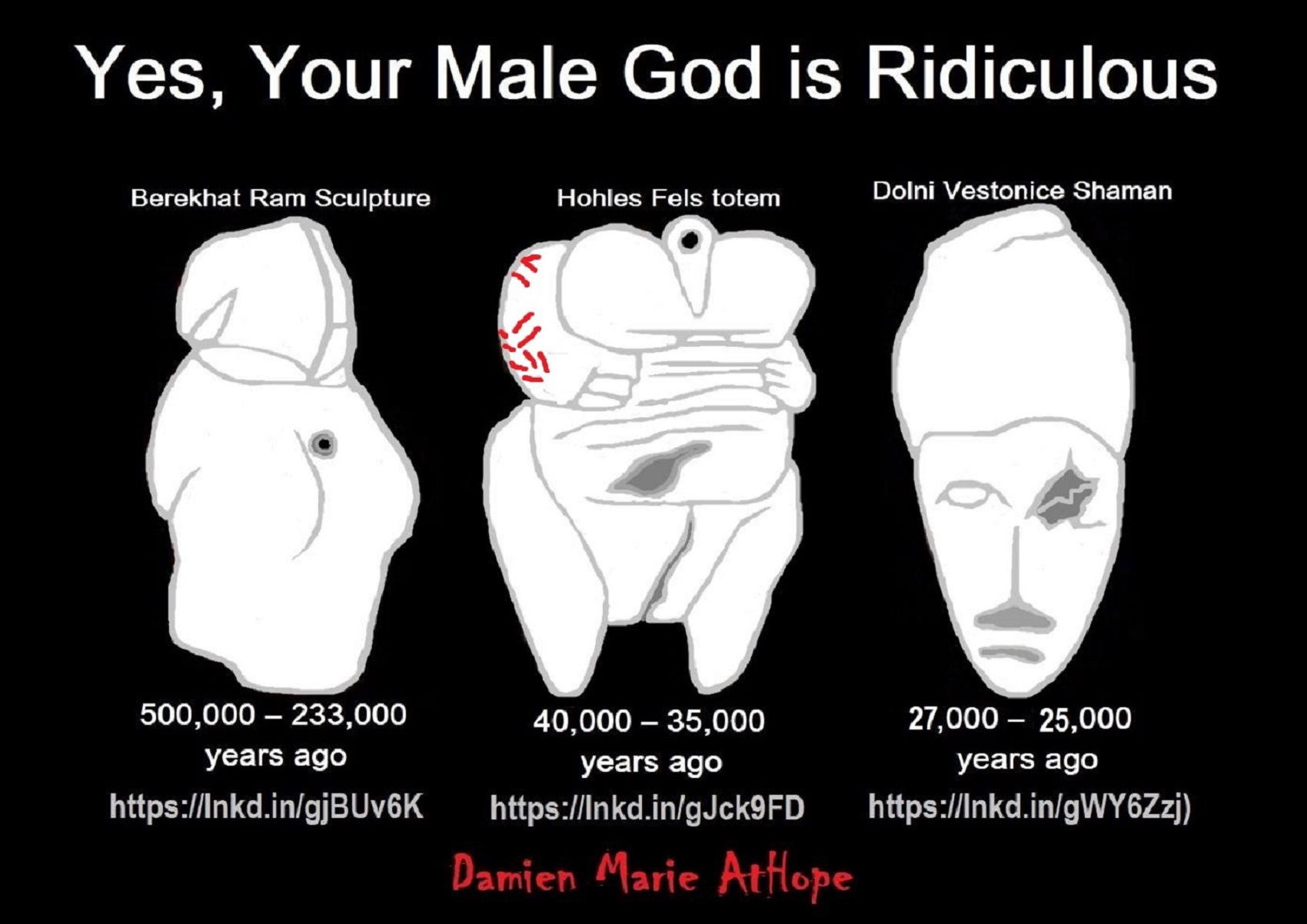
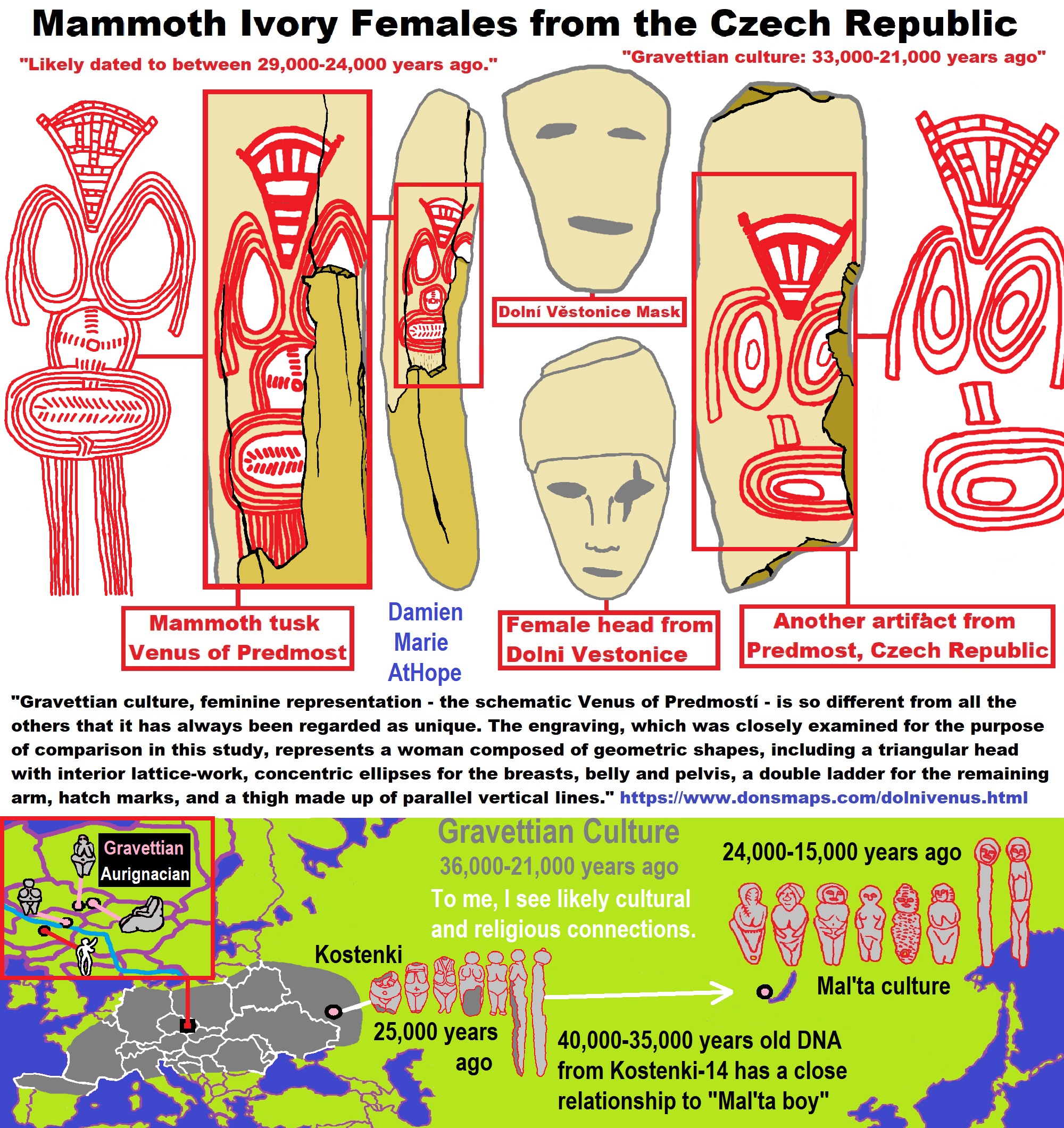
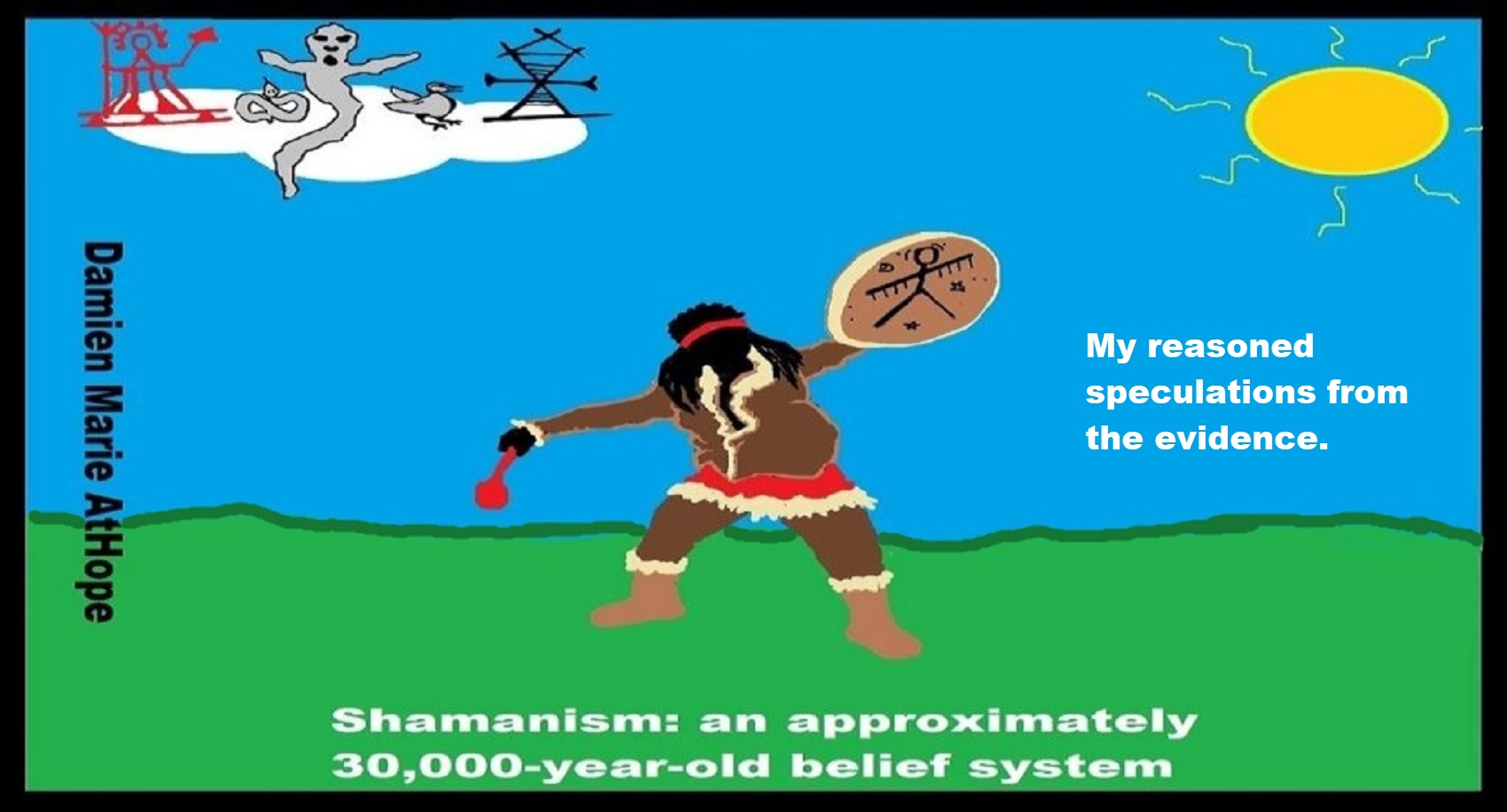
Shamanism (beginning around 30,000 years ago)
Shamanism (such as that seen in Siberia Gravettian culture: 30,000 years ago). Gravettian culture (34,000–24,000 years ago; Western Gravettian, mainly France, Spain, and Britain, as well as Eastern Gravettian in Central Europe and Russia. The eastern Gravettians, which include the Pavlovian culture). And, the Pavlovian culture (31,000 – 25,000 years ago such as in Austria and Poland). 31,000 – 20,000 years ago Oldest Shaman was Female, Buried with the Oldest Portrait Carving.
Shamanism is approximately a 30,000-year-old belief system and believe in spirit-filled life and/or afterlife that can be attached to or be expressed in things or objects and these objects can be used by special persons or in special rituals that can connect to spirit-filled life and/or afterlife. If you believe like this, regardless of your faith, you are a hidden shamanist.
Around 29,000 to 25,000 years ago in Dolní Vestonice, Czech Republic, the oldest human face representation is a carved ivory female head that was found nearby a female burial and belong to the Pavlovian culture, a variant of the Gravettian culture. The left side of the figure’s face was a distorted image and is believed to be a portrait of an elder female, who was around 40 years old. She was ritualistically placed beneath a pair of mammoth scapulae, one leaning against the other. Surprisingly, the left side of the skull was disfigured in the same manner as the aforementioned carved ivory figure, indicating that the figure was an intentional depiction of this specific individual. The bones and the earth surrounding the body contained traces of red ocher, a flint spearhead had been placed near the skull, and one hand held the body of a fox. This evidence suggests that this was the burial site of a shaman. This is the oldest site not only of ceramic figurines and artistic portraiture but also of evidence of early female shamans. Before 5,500 years ago, women were much more prominent in religion.
Archaeologists usually describe two regional variants: the western Gravettian, known namely from cave sites in France, Spain, and Britain, and the eastern Gravettian in Central Europe and Russia. The eastern Gravettians include the Pavlovian culture, which were specialized mammoth hunters and whose remains are usually found not in caves but in open air sites. The origins of the Gravettian people are not clear, they seem to appear simultaneously all over Europe. Though they carried distinct genetic signatures, the Gravettians and Aurignacians before them were descended from the same ancient founder population. According to genetic data, 37,000 years ago, all Europeans can be traced back to a single ‘founding population’ that made it through the last ice age. Furthermore, the so-called founding fathers were part of the Aurignacian culture, which was displaced by another group of early humans members of the Gravettian culture. Between 37,000 years ago and 14,000 years ago, different groups of Europeans were descended from a single founder population. To a greater extent than their Aurignacian predecessors, they are known for their Venus figurines. ref, ref, ref, ref, ref, ref, ref, ref, ref, ref, & ref
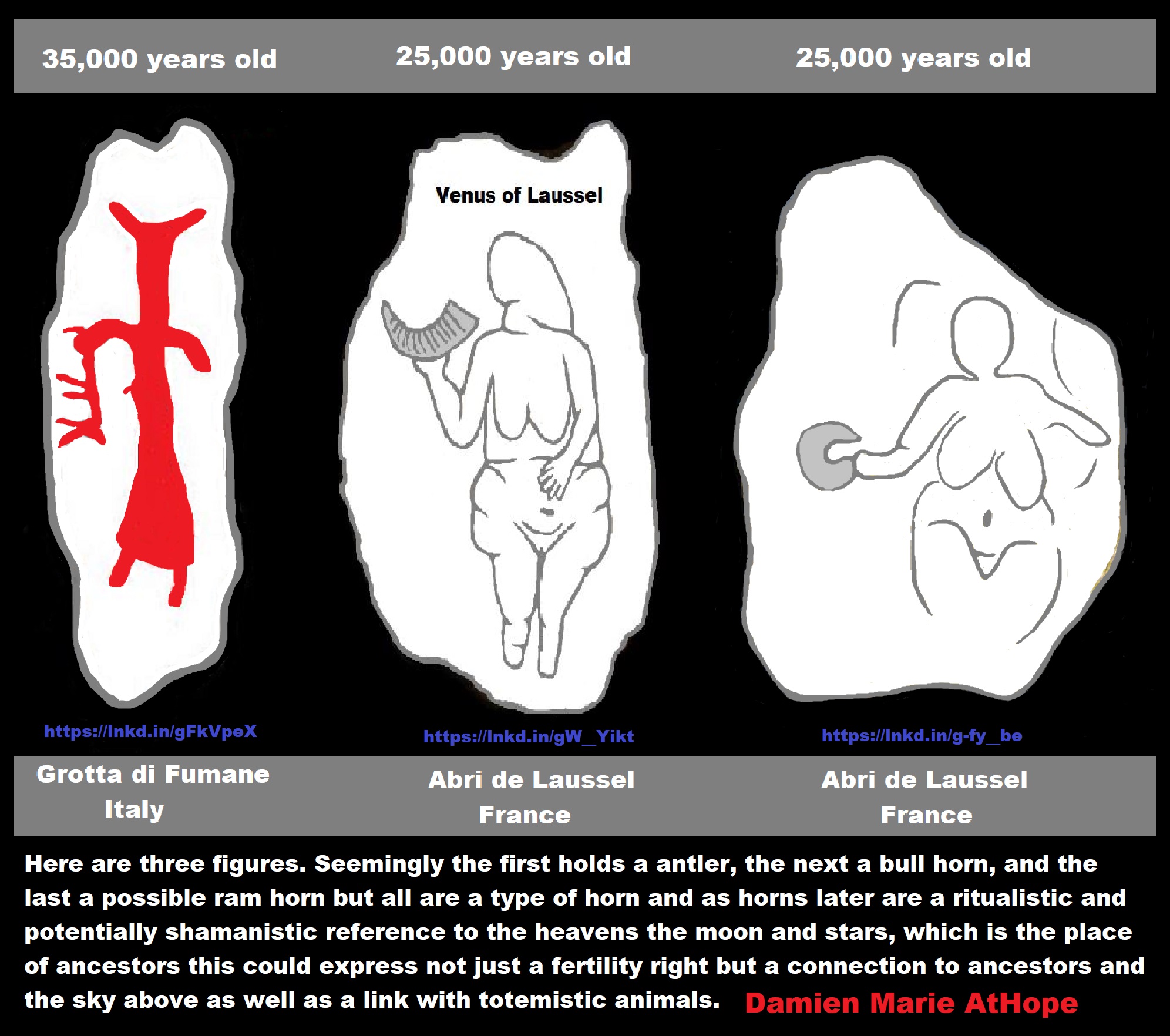
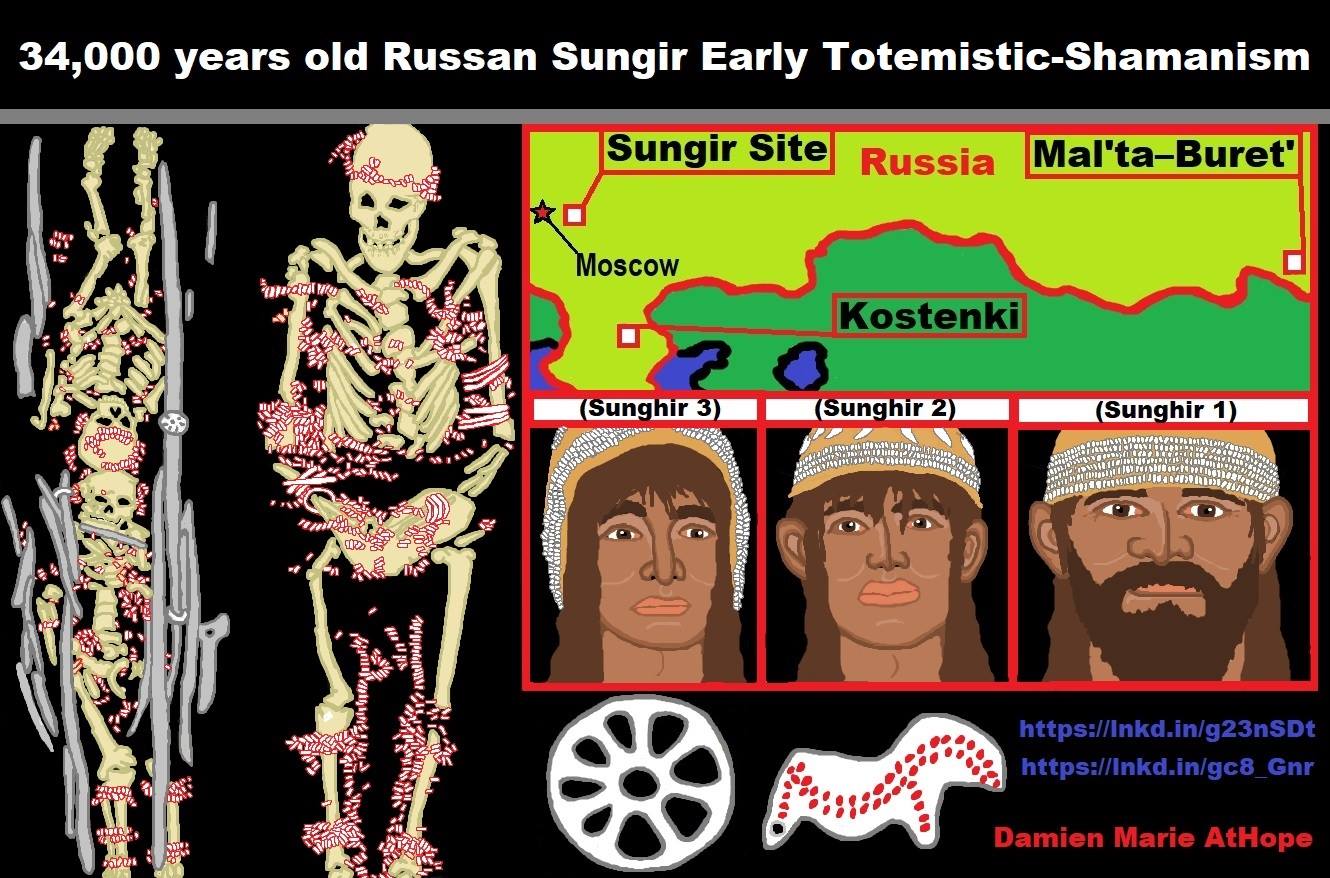
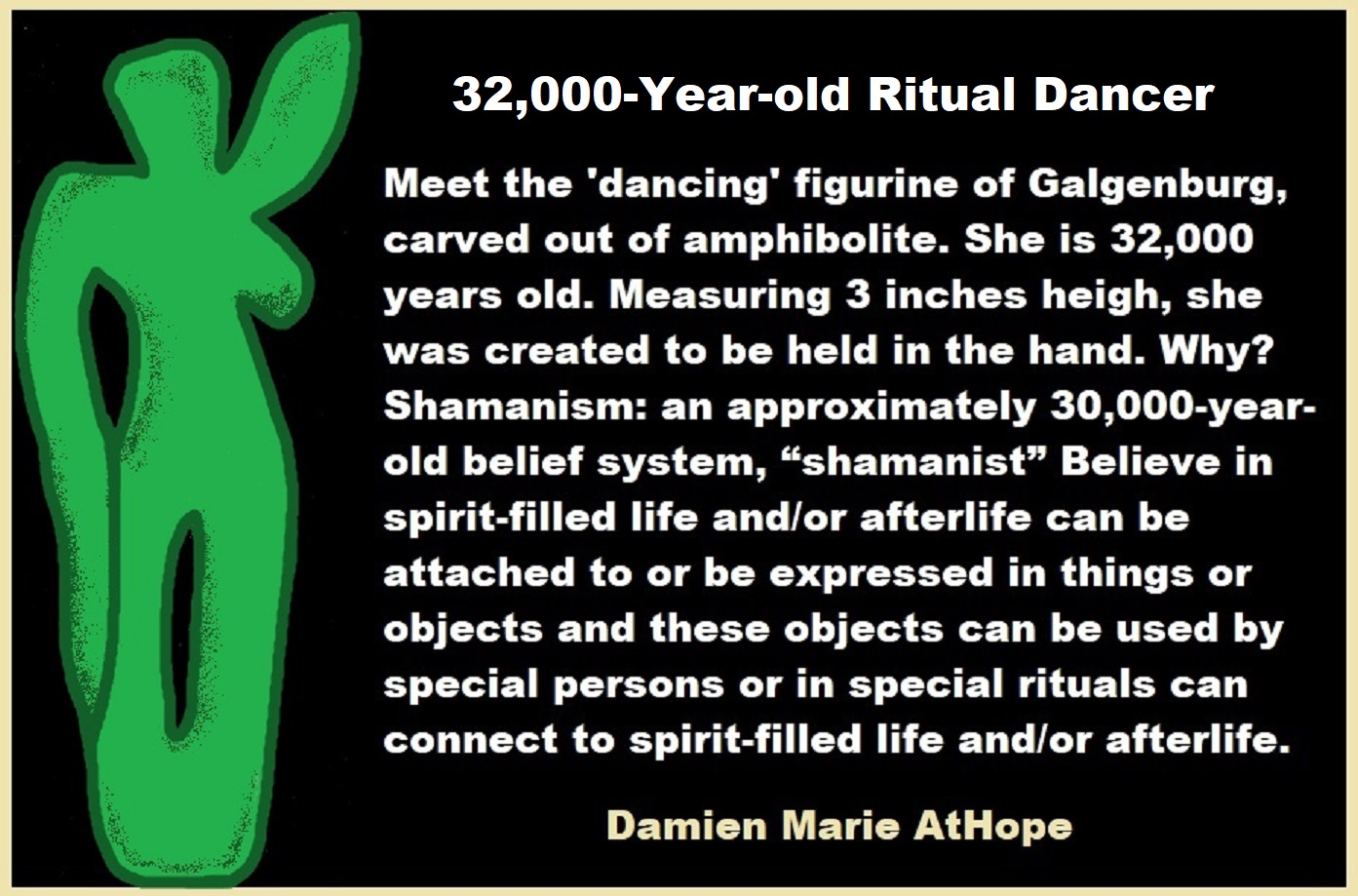
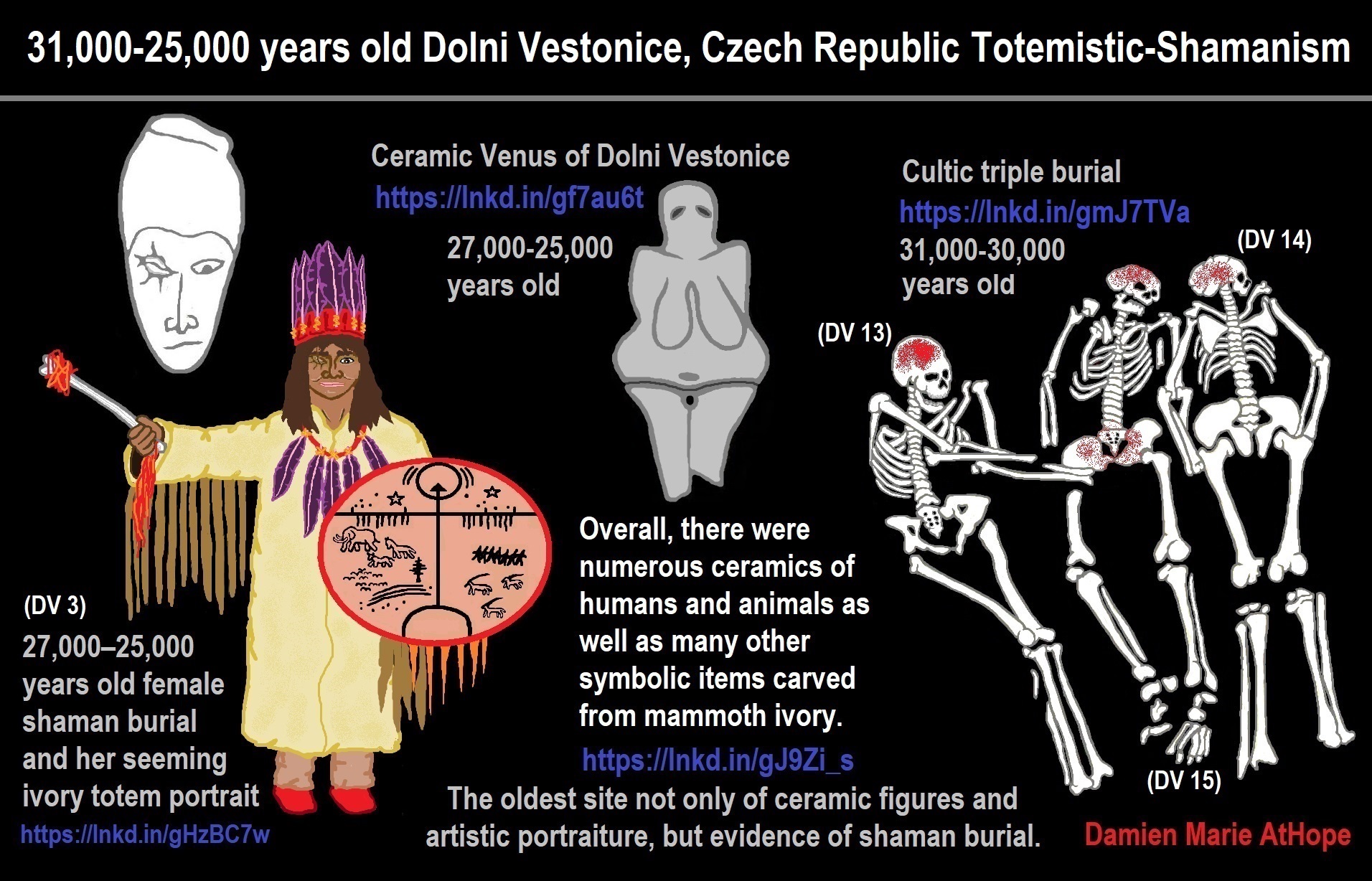

Shamanism is semi-holistic, between Animism and Totemism. Shamanism is somewhat neofeminine, referring to “new”‘ forms of femininistic style in nature compared to Totemism, tending to go slightly back to a more animalistic sensibility than a totemistic one. Though it has elements if totemism as well where a shaman evokes animal images as spirit guides, omens, and message-bearers including throw bones/runes. Things in nature can be accessed by a shaman who is believed to have sacred access to, and influence in, the world of benevolent and malevolent spirits. Most believe in spirits, existing somewhere on the animism/pantheism spectrum, they actively pursue contact with the “spirit-world” in altered states of consciousness by drumming, dance, or the use of sacred plants some with euphoric or hallucinatory effect. Pantheism is the belief that all reality is identical with divinity, or that everything composes an all-encompassing, immanent god. Pantheists do not believe in a personal or anthropomorphic god and hold a broad range of doctrines differing with regards to the forms of and relationships between divinity and reality. Though there are a variety of definitions of pantheism, ranging from a theological and philosophical position concerning God on one side as a religious position in this way, is expressed as a polar opposite of atheism. Whereas on the other hand, some hold that pantheism is a non-religious philosophical position that can be compatible with science. To them, according to the World Pantheist Movement, Scientific pantheism is the only form of spirituality we know of which fully embraces science as part of the human exploration of Earth and Cosmos. And, such pantheism, in general, may hold the view that the Universe (in the sense of the totality of all existence) and God are identical (implying a denial of the personality and transcendence of God). They assert that scientific pantheism respects the rights not just of humans, but of all living beings. It focuses on saving the planet rather than “saving” souls. To them, it encourages you to make the most and best of your one life here. It values reason and the scientific method over adherence to ancient scriptures. Scientific pantheism moves beyond “God” and defines itself by positives. Shamanism may have something like deities, though they tend to be more like pantheism or metaphorical deism/polytheism. Deism is a philosophical position that posits that God (or in some cases, gods) does not interfere directly with the world; conversely it can also be stated as a system of belief which posits God’s existence as the cause of all things, and admits His perfection (and usually the existence of natural law and Providence) but rejects Divine revelation or direct intervention of God in the universe by miracles. It also rejects revelation as a source of religious knowledge and asserts that reason and observation of the natural world are sufficient to determine the existence of a single creator or absolute principle of the universe. Shamanism may have many supernatural beings both animal and human-like Animism animal deities are common but the more anthropomorphic ones that are human like have a different level of power. Anthropomorphic human-like ones can be both somewhat personal and nonpersonal with a shared metaphorical ancestor grandmother/grandfather or great grandmother/grandfather deism/polytheism, not as much of what we think about like a god today. The wounded healer is an archetype, such as a shamanistic crisis, a rite of passage for shamans-to-be, commonly involving physical illness (pushes them to the brink of death, thought to give them access to the spirit world) and/or psychological crisis but can also involve a disformity or abnormality. My art of the bird could be a chicken, and the shake is viewed as dangerous but also useful, in fact, the usefulness of animals is sacralized, even including animals as a sacrificial use in shamanic rituals for at least around 5,000 years ago, using animals with great respect. ref, ref, ref
Religious Belief is Nothing Special
In general, religious belief is a geography issue and not because of any truth in the belief. This is evident in how 73% of the world’s religionists live in countries in which their religious persuasion makes up a majority of the population Pew Research Center studies show. So, stop thinking you were somehow blessed to be born into the one true religion.
If you are a religious believer, may I remind you that faith in the acquisition of knowledge is not a valid method worth believing in. Because, what proof is “faith”, of anything religion claims by faith, as many people have different faith even in the same religion?
Religious Sexism
- Speech on the Evolution of Religion & Religious Sexism
- Sexism in the Major World Religions
- Sexism in the BIBLE: chapter and verse!
- Sexism in Christianity (New Testament)
- Sexism in Judaism (old Testament)
- Sexism in Islam? Face Covering: Religious Freedom or Religious Oppression
- Sexism in Islam
- Sexism in Protestantism
- Sexism in Catholicism
- Sexism in Mormonism
- Sexism in Jehovah Witness
- Sexism in Bahaism
- Sexism in Sikhism
- Sexism in Confucianism
- Sexism in Taoism
- Sexism in Jainism
- Sexism in Shintoism
- Sexism in Buddhism
- Sexist Buddha
- Sexism in Hinduism
- Taoism yang and yin is very sexist
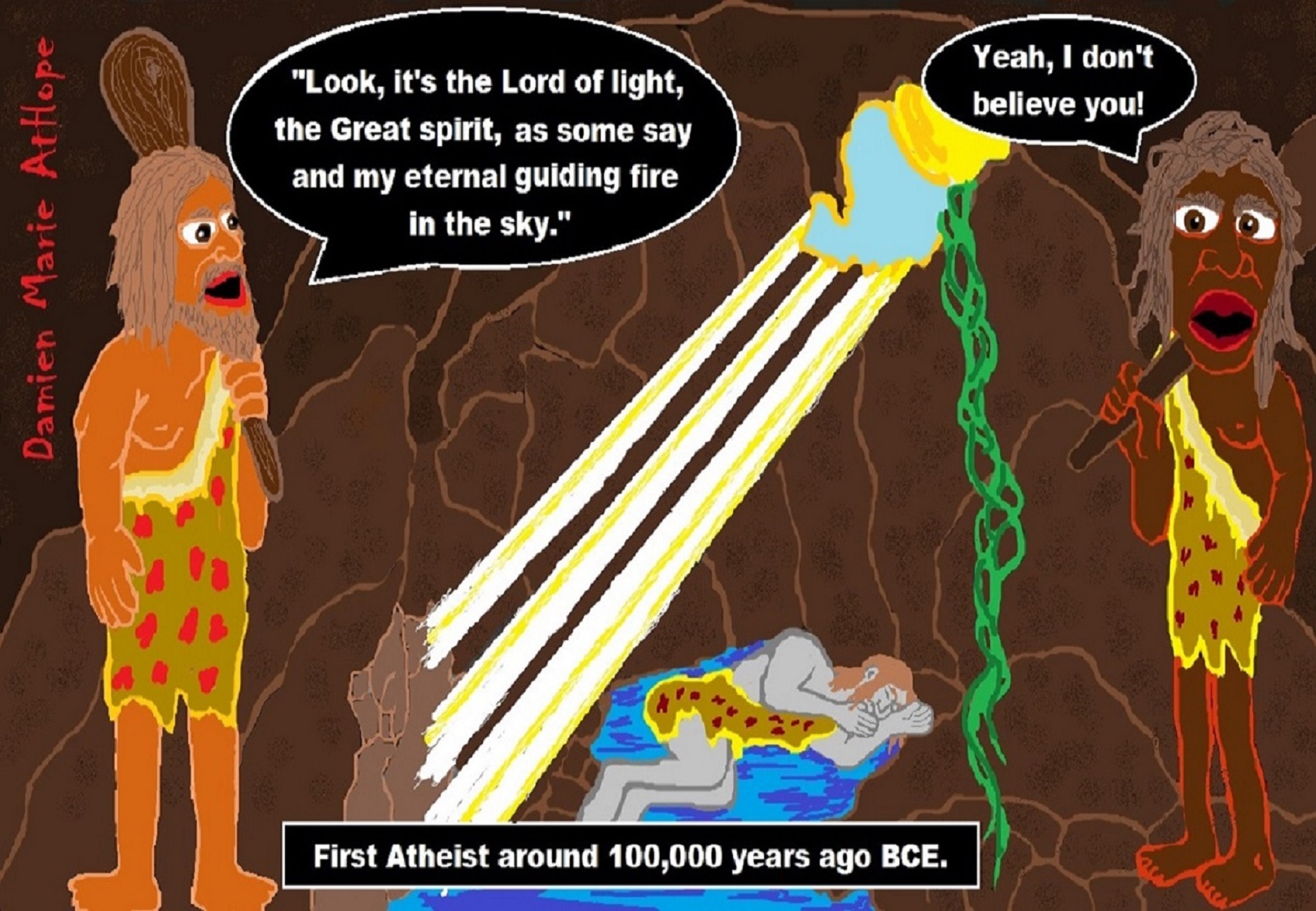

Animism: Respecting the Living World by Graham Harvey
“How have human cultures engaged with and thought about animals, plants, rocks, clouds, and other elements in their natural surroundings? Do animals and other natural objects have a spirit or soul? What is their relationship to humans? In this new study, Graham Harvey explores current and past animistic beliefs and practices of Native Americans, Maori, Aboriginal Australians, and eco-pagans. He considers the varieties of animism found in these cultures as well as their shared desire to live respectfully within larger natural communities. Drawing on his extensive casework, Harvey also considers the linguistic, performative, ecological, and activist implications of these different animisms.” ref




My thoughts on Religion Evolution with external links for more info:
- (Pre-Animism Africa mainly, but also Europe, and Asia at least 300,000 years ago), (Pre-Animism – Oxford Dictionaries)
- (Animism Africa around 100,000 years ago), (Animism – Britannica.com)
- (Totemism Europe around 50,000 years ago), (Totemism – Anthropology)
- (Shamanism Siberia around 30,000 years ago), (Shamanism – Britannica.com)
- (Paganism Turkey around 12,000 years ago), (Paganism – BBC Religion)
- (Progressed Organized Religion “Institutional Religion” Egypt around 5,000 years ago), (Ancient Egyptian Religion – Britannica.com)
- (CURRENT “World” RELIGIONS after 4,000 years ago) (Origin of Major Religions – Sacred Texts)
- (Early Atheistic Doubting at least by 2,600 years ago) (History of Atheism – Wikipedia)
“Religion is an Evolved Product” and Yes, Religion is Like Fear Given Wings…
Atheists talk about gods and religions for the same reason doctors talk about cancer, they are looking for a cure, or a firefighter talks about fires because they burn people and they care to stop them. We atheists too often feel a need to help the victims of mental slavery, held in the bondage that is the false beliefs of gods and the conspiracy theories of reality found in religions.
Understanding Religion Evolution:
- Pre-Animism (at least 300,000 years ago)
- Animism (Africa: 100,000 years ago)
- Totemism (Europe: 50,000 years ago)
- Shamanism (Siberia: 30,000 years ago)
- Paganism (Turkey: 12,000 years ago)
- Progressed organized religion (Egypt: 5,000 years ago), (Egypt, the First Dynasty 5,150 years ago)
- CURRENT “World” RELIGIONS (after 4,000 years ago)
- Early Atheistic Doubting (at least by 2,600 years ago)
“An Archaeological/Anthropological Understanding of Religion Evolution”
It seems ancient peoples had to survived amazing threats in a “dangerous universe (by superstition perceived as good and evil),” and human “immorality or imperfection of the soul” which was thought to affect the still living, leading to ancestor worship. This ancestor worship presumably led to the belief in supernatural beings, and then some of these were turned into the belief in gods. This feeble myth called gods were just a human conceived “made from nothing into something over and over, changing, again and again, taking on more as they evolve, all the while they are thought to be special,” but it is just supernatural animistic spirit-belief perceived as sacred.
Quick Evolution of Religion?
Pre-Animism (at least 300,000 years ago) pre-religion is a beginning that evolves into later Animism. So, Religion as we think of it, to me, all starts in a general way with Animism (Africa: 100,000 years ago) (theoretical belief in supernatural powers/spirits), then this is physically expressed in or with Totemism (Europe: 50,000 years ago) (theoretical belief in mythical relationship with powers/spirits through a totem item), which then enlists a full-time specific person to do this worship and believed interacting Shamanism (Siberia/Russia: 30,000 years ago) (theoretical belief in access and influence with spirits through ritual), and then there is the further employment of myths and gods added to all the above giving you Paganism (Turkey: 12,000 years ago) (often a lot more nature-based than most current top world religions, thus hinting to their close link to more ancient religious thinking it stems from). My hypothesis is expressed with an explanation of the building of a theatrical house (modern religions development). Progressed organized religion (Egypt: 5,000 years ago) with CURRENT “World” RELIGIONS (after 4,000 years ago).
Historically, in large city-state societies (such as Egypt or Iraq) starting around 5,000 years ago culminated to make religion something kind of new, a sociocultural-governmental-religious monarchy, where all or at least many of the people of such large city-state societies seem familiar with and committed to the existence of “religion” as the integrated life identity package of control dynamics with a fixed closed magical doctrine, but this juggernaut integrated religion identity package of Dogmatic-Propaganda certainly did not exist or if developed to an extent it was highly limited in most smaller prehistoric societies as they seem to lack most of the strong control dynamics with a fixed closed magical doctrine (magical beliefs could be at times be added or removed). Many people just want to see developed religious dynamics everywhere even if it is not. Instead, all that is found is largely fragments until the domestication of religion.
Religions, as we think of them today, are a new fad, even if they go back to around 6,000 years in the timeline of human existence, this amounts to almost nothing when seen in the long slow evolution of religion at least around 70,000 years ago with one of the oldest ritual worship. Stone Snake of South Africa: “first human worship” 70,000 years ago. This message of how religion and gods among them are clearly a man-made thing that was developed slowly as it was invented and then implemented peace by peace discrediting them all. Which seems to be a simple point some are just not grasping how devastating to any claims of truth when we can see the lie clearly in the archeological sites.
I wish people fought as hard for the actual values as they fight for the group/clan names political or otherwise they think support values. Every amount spent on war is theft to children in need of food or the homeless kept from shelter.
Here are several of my blog posts on history:
- To Find Truth You Must First Look
- (Magdalenian/Iberomaurusian) Connections to the First Paganists of the early Neolithic Near East Dating from around 17,000 to 12,000 Years Ago
- Natufians: an Ancient People at the Origins of Agriculture and Sedentary Life
- Possible Clan Leader/Special “MALE” Ancestor Totem Poles At Least 13,500 years ago?
- Jewish People with DNA at least 13,200 years old, Judaism, and the Origins of Some of its Ideas
- Baltic Reindeer Hunters: Swiderian, Lyngby, Ahrensburgian, and Krasnosillya cultures 12,020 to 11,020 years ago are evidence of powerful migratory waves during the last 13,000 years and a genetic link to Saami and the Finno-Ugric peoples.
- The Rise of Inequality: patriarchy and state hierarchy inequality
- Fertile Crescent 12,500 – 9,500 Years Ago: fertility and death cult belief system?
- 12,400 – 11,700 Years Ago – Kortik Tepe (Turkey) Pre/early-Agriculture Cultic Ritualism
- Ritualistic Bird Symbolism at Gobekli Tepe and its “Ancestor Cult”
- Male-Homosexual (female-like) / Trans-woman (female) Seated Figurine from Gobekli Tepe
- Could a 12,000-year-old Bull Geoglyph at Göbekli Tepe relate to older Bull and Female Art 25,000 years ago and Later Goddess and the Bull cults like Catal Huyuk?
- Sedentism and the Creation of goddesses around 12,000 years ago as well as male gods after 7,000 years ago.
- Alcohol, where Agriculture and Religion Become one? Such as Gobekli Tepe’s Ritualistic use of Grain as Food and Ritual Drink
- Neolithic Ritual Sites with T-Pillars and other Cultic Pillars
- Paganism: Goddesses around 12,000 years ago then Male Gods after 7,000 years ago
- First Patriarchy: Split of Women’s Status around 12,000 years ago & First Hierarchy: fall of Women’s Status around 5,000 years ago.
- Natufians: an Ancient People at the Origins of Agriculture and Sedentary Life
- J DNA and the Spread of Agricultural Religion (paganism)
- Paganism: an approximately 12,000-year-old belief system
- Paganism 12,000 years old: related to “Anarchism and Socialism” (Pre-Capitalism)
- Shaman burial in Israel 12,000 years ago and the Shamanism Phenomena
- Need to Mythicized: gods and goddesses
- 12,000 – 7,000 Years Ago – Paleo-Indian Culture (The Americas)
- 12,000 – 2,000 Years Ago – Indigenous-Scandinavians (Nordic)
- Norse did not wear helmets with horns?
- Pre-Pottery Neolithic Skull Cult around 11,500 to 8,400 Years Ago?
- 10,400 – 10,100 Years Ago, in Turkey the Nevail Cori Religious Settlement
- 9,000-6,500 Years Old Submerged Pre-Pottery/Pottery Neolithic Ritual Settlements off Israel’s Coast
- Catal Huyuk “first religious designed city” around 9,500 to 7,700 years ago (Turkey)
- Cultic Hunting at Catal Huyuk “first religious designed city”
- Special Items and Art as well as Special Elite Burials at Catal Huyuk
- New Rituals and Violence with the appearance of Pottery and People?
- Haplogroup N and its related Uralic Languages and Cultures
- Ainu people, Sámi people, Native Americans, the Ancient North Eurasians, and Paganistic-Shamanism with Totemism
- Ideas, Technology and People from Turkey, Europe, to China and Back again 9,000 to 5,000 years ago?
- First Pottery of Europe and the Related Cultures
- 9,000 years old Neolithic Artifacts Judean Desert and Hills Israel
- 9,000-7,000 years-old Sex and Death Rituals: Cult Sites in Israel, Jordan, and the Sinai
- 9,000-8500 year old Horned Female shaman Bad Dürrenberg Germany
- Neolithic Jewelry and the Spread of Farming in Europe Emerging out of West Turkey
- 8,600-year-old Tortoise Shells in Neolithic graves in central China have Early Writing and Shamanism
- Swing of the Mace: the rise of Elite, Forced Authority, and Inequality begin to Emerge 8,500 years ago?
- Migrations and Changing Europeans Beginning around 8,000 Years Ago
- My “Steppe-Anatolian-Kurgan hypothesis” 8,000/7,000 years ago
- Around 8,000-year-old Shared Idea of the Mistress of Animals, “Ritual” Motif
- Pre-Columbian Red-Paint (red ochre) Maritime Archaic Culture 8,000-3,000 years ago
- 7,522-6,522 years ago Linear Pottery culture which I think relates to Arcane Capitalism’s origins
- Arcane Capitalism: Primitive socialism, Primitive capital, Private ownership, Means of production, Market capitalism, Class discrimination, and Petite bourgeoisie (smaller capitalists)
- 7,500-4,750 years old Ritualistic Cucuteni-Trypillian culture of Moldova, Romania, and Ukraine
- Roots of a changing early society 7,200-6,700 years ago Jordan and Israel
- Agriculture religion (Paganism) with farming reached Britain between about 7,000 to 6,500 or so years ago and seemingly expressed in things like Western Europe’s Long Barrows
- My Thoughts on Possible Migrations of “R” DNA and Proto-Indo-European?
- “Millet” Spreading from China 7,022 years ago to Europe and related Language may have Spread with it leading to Proto-Indo-European
- Proto-Indo-European (PIE), ancestor of Indo-European languages: DNA, Society, Language, and Mythology
- The Dnieper–Donets culture and Asian varieties of Millet from China to the Black Sea region of Europe by 7,022 years ago
- Kurgan 6,000 years ago/dolmens 7,000 years ago: funeral, ritual, and other?
- 7,020 to 6,020-year-old Proto-Indo-European Homeland of Urheimat or proposed home of their Language and Religion
- Ancient Megaliths: Kurgan, Ziggurat, Pyramid, Menhir, Trilithon, Dolman, Kromlech, and Kromlech of Trilithons
- The Mytheme of Ancient North Eurasian Sacred-Dog belief and similar motifs are found in Indo-European, Native American, and Siberian comparative mythology
- Elite Power Accumulation: Ancient Trade, Tokens, Writing, Wealth, Merchants, and Priest-Kings
- Sacred Mounds, Mountains, Kurgans, and Pyramids may hold deep connections?
- Between 7,000-5,000 Years ago, rise of unequal hierarchy elite, leading to a “birth of the State” or worship of power, strong new sexism, oppression of non-elites, and the fall of Women’s equal status
- Paganism 7,000-5,000 years old: related to “Anarchism and Socialism” (Capitalism) (World War 0) Elite & their slaves
- Hell and Underworld mythologies starting maybe as far back as 7,000 to 5,000 years ago with the Proto-Indo-Europeans?
- The First Expression of the Male God around 7,000 years ago?
- White (light complexion skin) Bigotry and Sexism started 7,000 years ago?
- Around 7,000-year-old Shared Idea of the Divine Bird (Tutelary and/or Trickster spirit/deity), “Ritual” Motif
- Nekhbet an Ancient Egyptian Vulture Goddess and Tutelary Deity
- 6,720 to 4,920 years old Ritualistic Hongshan Culture of Inner Mongolia with 5,000-year-old Pyramid Mounds and Temples
- First proto-king in the Balkans, Varna culture around 6,500 years ago?
- 6,500–5,800 years ago in Israel Late Chalcolithic (Copper Age) Period in the Southern Levant Seems to Express Northern Levant Migrations, Cultural and Religious Transfer
- KING OF BEASTS: Master of Animals “Ritual” Motif, around 6,000 years old or older…
- Around 6000-year-old Shared Idea of the Solid Wheel & the Spoked Wheel-Shaped Ritual Motif
- “The Ghassulian Star,” a mysterious 6,000-year-old mural from Jordan; a Proto-Star of Ishtar, Star of Inanna or Star of Venus?
- Religious/Ritual Ideas, including goddesses and gods as well as ritual mounds or pyramids from Northeastern Asia at least 6,000 years old, seemingly filtering to Iran, Iraq, the Mediterranean, Europe, Egypt, and the Americas?
- Maykop (5,720–5,020 years ago) Caucasus region Bronze Age culture-related to Copper Age farmers from the south, influenced by the Ubaid period and Leyla-Tepe culture, as well as influencing the Kura-Araxes culture
- 5-600-year-old Tomb, Mummy, and First Bearded Male Figurine in a Grave
- Kura-Araxes Cultural 5,520 to 4,470 years old DNA traces to the Canaanites, Arabs, and Jews
- Minoan/Cretan (Keftiu) Civilization and Religion around 5,520 to 3,120 years ago
- Evolution Of Science at least by 5,500 years ago
- 5,500 Years old birth of the State, the rise of Hierarchy, and the fall of Women’s status
- “Jiroft culture” 5,100 – 4,200 years ago and the History of Iran
- Stonehenge: Paganistic Burial and Astrological Ritual Complex, England (5,100-3,600 years ago)
- Around 5,000-year-old Shared Idea of the “Tree of Life” Ritual Motif
- Complex rituals for elite, seen from China to Egypt, at least by 5,000 years ago
- Around 5,000 years ago: “Birth of the State” where Religion gets Military Power and Influence
- The Center of the World “Axis Mundi” and/or “Sacred Mountains” Mythology Could Relate to the Altai Mountains, Heart of the Steppe
- Progressed organized religion starts, an approximately 5,000-year-old belief system
- China’s Civilization between 5,000-3,000 years ago, was a time of war and class struggle, violent transition from free clans to a Slave or Elite society
- Origin of Logics is Naturalistic Observation at least by around 5,000 years ago.
- Paganism 5,000 years old: progressed organized religion and the state: related to “Anarchism and Socialism” (Kings and the Rise of the State)
- Ziggurats (multi-platform temples: 4,900 years old) to Pyramids (multi-platform tombs: 4,700 years old)
- Did a 4,520–4,420-year-old Volcano In Turkey Inspire the Bible God?
- Finland’s Horned Shaman and Pre-Horned-God at least 4,500 years ago?
- 4,000-year-Old Dolmens in Israel: A Connected Dolmen Religious Phenomenon?
- Creation myths: From chaos, Ex nihilo, Earth-diver, Emergence, World egg, and World parent
- Bronze Age “Ritual” connections of the Bell Beaker culture with the Corded Ware/Single Grave culture, which were related to the Yamnaya culture and Proto-Indo-European Languages/Religions
- Low Gods (Earth/ Tutelary deity), High Gods (Sky/Supreme deity), and Moralistic Gods (Deity enforcement/divine order)
- The exchange of people, ideas, and material-culture including, to me, the new god (Sky Father) and goddess (Earth Mother) religion between the Cucuteni-Trypillians and others which is then spread far and wide
- Koryaks: Indigenous People of the Russian Far East and Big Raven myths also found in Tlingit, Haida, Tsimshian, and other Indigenous People of North America
- 42 Principles Of Maat (Egyptian Goddess of the justice) around 4,400 years ago, 2000 Years Before Ten Commandments
- “Happy Easter” Well Happy Eostre/Ishter
- 4,320-3,820 years old “Shimao” (North China) site with Totemistic-Shamanistic Paganism and a Stepped Pyramid
- 4,250 to 3,400 Year old Stonehenge from Russia: Arkaim?
- 4,100-year-old beaker with medicinal & flowering plants in a grave of a woman in Scotland
- Early European Farmer ancestry, Kelif el Boroud people with the Cardial Ware culture, and the Bell Beaker culture Paganists too, spread into North Africa, then to the Canary Islands off West Africa
- Flood Accounts: Gilgamesh epic (4,100 years ago) Noah in Genesis (2,600 years ago)
- Paganism 4,000 years old: related to “Anarchism and Socialism” (First Moralistic gods, then the Origin time of Monotheism)
- When was the beginning: TIMELINE OF CURRENT RELIGIONS, which start around 4,000 years ago.
- Early Religions Thought to Express Proto-Monotheistic Systems around 4,000 years ago
- Kultepe? An archaeological site with a 4,000 years old women’s rights document.
- Single God Religions (Monotheism) = “Man-o-theism” started around 4,000 years ago with the Great Sky Spirit/God Tiān (天)?
- Confucianism’s Tiān (Shangdi god 4,000 years old): Supernaturalism, Pantheism or Theism?
- Yes, Your Male God is Ridiculous
- Mythology, a Lunar Deity is a Goddess or God of the Moon
- Sacred Land, Hills, and Mountains: Sami Mythology (Paganistic Shamanism)
- Horse Worship/Sacrifice: mythical union of Ruling Elite/Kingship and the Horse
- The Amorite/Amurru people’s God Amurru “Lord of the Steppe”, relates to the Origins of the Bible God?
- Bronze Age Exotic Trade Routes Spread Quite Far as well as Spread Religious Ideas with Them
- Sami and the Northern Indigenous Peoples Landscape, Language, and its Connection to Religion
- Prototype of Ancient Analemmatic Sundials around 3,900-3,150 years ago and a Possible Solar Connection to gods?
- Judaism is around 3,450 or 3,250 years old. (“Paleo-Hebrew” 3,000 years ago and Torah 2,500 years ago)
- The Weakening of Ancient Trade and the Strengthening of Religions around 3000 years ago?
- Are you aware that there are religions that worship women gods, explain now religion tears women down?
- Animistic, Totemistic, and Paganistic Superstition Origins of bible god and the bible’s Religion.
- Myths and Folklore: “Trickster gods and goddesses”
- Jews, Judaism, and the Origins of Some of its Ideas
- An Old Branch of Religion Still Giving Fruit: Sacred Trees
- Dating the BIBLE: naming names and telling times (written less than 3,000 years ago, provable to 2,200 years ago)
- Did a Volcano Inspire the bible god?
- The Amorite/Amurru people’s God Amurru “Lord of the Steppe”, relates to the Origins of the Bible God?
- Dené–Yeniseian language, Old Copper Complex, and Pre-Columbian Mound Builders?
- No “dinosaurs and humans didn’t exist together just because some think they are in the bible itself”
- Sacred Shit and Sacred Animals?
- Everyone Killed in the Bible Flood? “Nephilim” (giants)?
- Hey, Damien dude, I have a question for you regarding “the bible” Exodus.
- Archaeology Disproves the Bible
- Bible Battle, Just More, Bible Babble
- The Jericho Conquest lie?
- Canaanites and Israelites?
- Accurate Account on how did Christianity Began?
- Let’s talk about Christianity.
- So the 10 commandments isn’t anything to go by either right?
- Misinformed christian
- Debunking Jesus?
- Paulism vs Jesus
- Ok, you seem confused so let’s talk about Buddhism.
- Unacknowledged Buddhism: Gods, Savior, Demons, Rebirth, Heavens, Hells, and Terrorism
- His Foolishness The Dalai Lama
- Yin and Yang is sexist with an ORIGIN around 2,300 years ago?
- I Believe Archaeology, not Myths & Why Not, as the Religious Myths Already Violate Reason!
- Archaeological, Scientific, & Philosophic evidence shows the god myth is man-made nonsense.
- Aquatic Ape Theory/Hypothesis? As Always, Just Pseudoscience.
- Ancient Aliens Conspiracy Theorists are Pseudohistorians
- The Pseudohistoric and Pseudoscientific claims about “Bakoni Ruins” of South Africa
- Why do people think Religion is much more than supernaturalism and superstitionism?
- Religion is an Evolved Product
- Was the Value of Ancient Women Different?
- 1000 to 1100 CE, human sacrifice Cahokia Mounds a pre-Columbian Native American site
- Feminist atheists as far back as the 1800s?
- Promoting Religion as Real is Mentally Harmful to a Flourishing Humanity
- Screw All Religions and Their Toxic lies, they are all fraud
- Forget Religions’ Unfounded Myths, I Have Substantiated “Archaeology Facts.”
- Religion Dispersal throughout the World
- I Hate Religion Just as I Hate all Pseudoscience
- Exposing Scientology, Eckankar, Wicca and Other Nonsense?
- Main deity or religious belief systems
- Quit Trying to Invent Your God From the Scraps of Science.
- Archaeological, Scientific, & Philosophic evidence shows the god myth is man-made nonsense.
- Ancient Alien Conspiracy Theorists: Misunderstanding, Rhetoric, Misinformation, Fabrications, and Lies
- Misinformation, Distortion, and Pseudoscience in Talking with a Christian Creationist
- Judging the Lack of Goodness in Gods, Even the Norse God Odin
- Challenging the Belief in God-like Aliens and Gods in General
- A Challenge to Christian use of Torture Devices?
- Yes, Hinduism is a Religion
- Trump is One of the Most Reactionary Forces of Far-right Christian Extremism
- Was the Bull Head a Symbol of God? Yes!
- Primate Death Rituals
- Christian – “God and Christianity are objectively true”
- Australopithecus afarensis Death Ritual?
- You Claim Global Warming is a Hoax?
- Doubter of Science and Defamer of Atheists?
- I think that sounds like the Bible?
- History of the Antifa (“anti-fascist”) Movements
- Indianapolis Anti-Blasphemy Laws #Free Soheil Rally
- Damien, you repeat the golden rule in so many forms then you say religion is dogmatic?
- Science is a Trustable Methodology whereas Faith is not Trustable at all!
- Was I ever a believer, before I was an atheist?
- Atheists rise in reason
- Mistrust of science?
- Open to Talking About the Definition of ‘God’? But first, we address Faith.
- ‘United Monarchy’ full of splendor and power – Saul, David, and Solomon? Most likely not.
- Is there EXODUS ARCHAEOLOGY? The short answer is “no.”
- Lacking Proof of Bigfoots, Unicorns, and Gods is Just a Lack of Research?
- Religion and Politics: Faith Beliefs vs. Rational Thinking
- Hammer of Truth that lying pig RELIGION: challenged by an archaeologist
- “The Hammer of Truth” -ontology question- What do You Mean by That?
- Navigation of a bad argument: Ad Hominem vs. Attack
- Why is it Often Claimed that Gods have a Gender?
- Why are basically all monotheistic religions ones that have a male god?
- Shifting through the Claims in support of Faith
- Dear Mr. AtHope, The 20th Century is an Indictment of Secularism and a Failed Atheist Century
- An Understanding of the Worldwide Statistics and Dynamics of Terrorist Incidents and Suicide Attacks
- Intoxication and Evolution? Addressing and Assessing the “Stoned Ape” or “Drunken Monkey” Theories as Catalysts in Human Evolution
- Sacred Menstrual cloth? Inanna’s knot, Isis knot, and maybe Ma’at’s feather?
- Damien, why don’t the Hebrews accept the bible stories?
- Dealing with a Troll and Arguing Over Word Meaning
- Knowledge without Belief? Justified beliefs or disbeliefs worthy of Knowledge?
- Afrocentrism and African Religions
- Crecganford @crecganford offers history & stories of the people, places, gods, & culture
- Empiricism-Denier?
I am not an academic. I am a revolutionary that teaches in public, in places like social media, and in the streets. I am not a leader by some title given but from my commanding leadership style of simply to start teaching everywhere to everyone, all manner of positive education.







ref, ref, ref, ref, ref, ref, ref, ref, ref, ref, ref, ref, ref, ref, ref, ref, ref, ref, ref, ref, ref
Low Gods “Earth” or Tutelary deity and High Gods “Sky” or Supreme deity
“An Earth goddess is a deification of the Earth. Earth goddesses are often associated with the “chthonic” deities of the underworld. Ki and Ninhursag are Mesopotamian earth goddesses. In Greek mythology, the Earth is personified as Gaia, corresponding to Roman Terra, Indic Prithvi/Bhūmi, etc. traced to an “Earth Mother” complementary to the “Sky Father” in Proto-Indo-European religion. Egyptian mythology exceptionally has a sky goddess and an Earth god.” ref
“A mother goddess is a goddess who represents or is a personification of nature, motherhood, fertility, creation, destruction or who embodies the bounty of the Earth. When equated with the Earth or the natural world, such goddesses are sometimes referred to as Mother Earth or as the Earth Mother. In some religious traditions or movements, Heavenly Mother (also referred to as Mother in Heaven or Sky Mother) is the wife or feminine counterpart of the Sky father or God the Father.” ref
“Any masculine sky god is often also king of the gods, taking the position of patriarch within a pantheon. Such king gods are collectively categorized as “sky father” deities, with a polarity between sky and earth often being expressed by pairing a “sky father” god with an “earth mother” goddess (pairings of a sky mother with an earth father are less frequent). A main sky goddess is often the queen of the gods and may be an air/sky goddess in her own right, though she usually has other functions as well with “sky” not being her main. In antiquity, several sky goddesses in ancient Egypt, Mesopotamia, and the Near East were called Queen of Heaven. Neopagans often apply it with impunity to sky goddesses from other regions who were never associated with the term historically. The sky often has important religious significance. Many religions, both polytheistic and monotheistic, have deities associated with the sky.” ref
“In comparative mythology, sky father is a term for a recurring concept in polytheistic religions of a sky god who is addressed as a “father”, often the father of a pantheon and is often either a reigning or former King of the Gods. The concept of “sky father” may also be taken to include Sun gods with similar characteristics, such as Ra. The concept is complementary to an “earth mother“. “Sky Father” is a direct translation of the Vedic Dyaus Pita, etymologically descended from the same Proto-Indo-European deity name as the Greek Zeûs Pater and Roman Jupiter and Germanic Týr, Tir or Tiwaz, all of which are reflexes of the same Proto-Indo-European deity’s name, *Dyēus Ph₂tḗr. While there are numerous parallels adduced from outside of Indo-European mythology, there are exceptions (e.g. In Egyptian mythology, Nut is the sky mother and Geb is the earth father).” ref
Tutelary deity
“A tutelary (also tutelar) is a deity or spirit who is a guardian, patron, or protector of a particular place, geographic feature, person, lineage, nation, culture, or occupation. The etymology of “tutelary” expresses the concept of safety and thus of guardianship. In late Greek and Roman religion, one type of tutelary deity, the genius, functions as the personal deity or daimon of an individual from birth to death. Another form of personal tutelary spirit is the familiar spirit of European folklore.” ref
“A tutelary (also tutelar) in Korean shamanism, jangseung and sotdae were placed at the edge of villages to frighten off demons. They were also worshiped as deities. Seonangshin is the patron deity of the village in Korean tradition and was believed to embody the Seonangdang. In Philippine animism, Diwata or Lambana are deities or spirits that inhabit sacred places like mountains and mounds and serve as guardians. Such as: Maria Makiling is the deity who guards Mt. Makiling and Maria Cacao and Maria Sinukuan. In Shinto, the spirits, or kami, which give life to human bodies come from nature and return to it after death. Ancestors are therefore themselves tutelaries to be worshiped. And similarly, Native American beliefs such as Tonás, tutelary animal spirit among the Zapotec and Totems, familial or clan spirits among the Ojibwe, can be animals.” ref
“A tutelary (also tutelar) in Austronesian beliefs such as: Atua (gods and spirits of the Polynesian peoples such as the Māori or the Hawaiians), Hanitu (Bunun of Taiwan‘s term for spirit), Hyang (Kawi, Sundanese, Javanese, and Balinese Supreme Being, in ancient Java and Bali mythology and this spiritual entity, can be either divine or ancestral), Kaitiaki (New Zealand Māori term used for the concept of guardianship, for the sky, the sea, and the land), Kawas (mythology) (divided into 6 groups: gods, ancestors, souls of the living, spirits of living things, spirits of lifeless objects, and ghosts), Tiki (Māori mythology, Tiki is the first man created by either Tūmatauenga or Tāne and represents deified ancestors found in most Polynesian cultures). ” ref, ref, ref, ref, ref, ref, ref
Mesopotamian Tutelary Deities can be seen as ones related to City-States
“Historical city-states included Sumerian cities such as Uruk and Ur; Ancient Egyptian city-states, such as Thebes and Memphis; the Phoenician cities (such as Tyre and Sidon); the five Philistine city-states; the Berber city-states of the Garamantes; the city-states of ancient Greece (the poleis such as Athens, Sparta, Thebes, and Corinth); the Roman Republic (which grew from a city-state into a vast empire); the Italian city-states from the Middle Ages to the early modern period, such as Florence, Siena, Ferrara, Milan (which as they grew in power began to dominate neighboring cities) and Genoa and Venice, which became powerful thalassocracies; the Mayan and other cultures of pre-Columbian Mesoamerica (including cities such as Chichen Itza, Tikal, Copán and Monte Albán); the central Asian cities along the Silk Road; the city-states of the Swahili coast; Ragusa; states of the medieval Russian lands such as Novgorod and Pskov; and many others.” ref
“The Uruk period (ca. 4000 to 3100 BCE; also known as Protoliterate period) of Mesopotamia, named after the Sumerian city of Uruk, this period saw the emergence of urban life in Mesopotamia and the Sumerian civilization. City-States like Uruk and others had a patron tutelary City Deity along with a Priest-King.” ref
“Chinese folk religion, both past, and present, includes myriad tutelary deities. Exceptional individuals, highly cultivated sages, and prominent ancestors can be deified and honored after death. Lord Guan is the patron of military personnel and police, while Mazu is the patron of fishermen and sailors. Such as Tu Di Gong (Earth Deity) is the tutelary deity of a locality, and each individual locality has its own Earth Deity and Cheng Huang Gong (City God) is the guardian deity of an individual city, worshipped by local officials and locals since imperial times.” ref
“A tutelary (also tutelar) in Hinduism, personal tutelary deities are known as ishta-devata, while family tutelary deities are known as Kuladevata. Gramadevata are guardian deities of villages. Devas can also be seen as tutelary. Shiva is the patron of yogis and renunciants. City goddesses include: Mumbadevi (Mumbai), Sachchika (Osian); Kuladevis include: Ambika (Porwad), and Mahalakshmi. In NorthEast India Meitei mythology and religion (Sanamahism) of Manipur, there are various types of tutelary deities, among which Lam Lais are the most predominant ones. Tibetan Buddhism has Yidam as a tutelary deity. Dakini is the patron of those who seek knowledge.” ref
“A tutelary (also tutelar) The Greeks also thought deities guarded specific places: for instance, Athena was the patron goddess of the city of Athens. Socrates spoke of hearing the voice of his personal spirit or daimonion:
You have often heard me speak of an oracle or sign which comes to me … . This sign I have had ever since I was a child. The sign is a voice which comes to me and always forbids me to do something which I am going to do, but never commands me to do anything, and this is what stands in the way of my being a politician.” ref
“Tutelary deities who guard and preserve a place or a person are fundamental to ancient Roman religion. The tutelary deity of a man was his Genius, that of a woman her Juno. In the Imperial era, the Genius of the Emperor was a focus of Imperial cult. An emperor might also adopt a major deity as his personal patron or tutelary, as Augustus did Apollo. Precedents for claiming the personal protection of a deity were established in the Republican era, when for instance the Roman dictator Sulla advertised the goddess Victory as his tutelary by holding public games (ludi) in her honor.” ref
“Each town or city had one or more tutelary deities, whose protection was considered particularly vital in time of war and siege. Rome itself was protected by a goddess whose name was to be kept ritually secret on pain of death (for a supposed case, see Quintus Valerius Soranus). The Capitoline Triad of Juno, Jupiter, and Minerva were also tutelaries of Rome. The Italic towns had their own tutelary deities. Juno often had this function, as at the Latin town of Lanuvium and the Etruscan city of Veii, and was often housed in an especially grand temple on the arx (citadel) or other prominent or central location. The tutelary deity of Praeneste was Fortuna, whose oracle was renowned.” ref
“The Roman ritual of evocatio was premised on the belief that a town could be made vulnerable to military defeat if the power of its tutelary deity were diverted outside the city, perhaps by the offer of superior cult at Rome. The depiction of some goddesses such as the Magna Mater (Great Mother, or Cybele) as “tower-crowned” represents their capacity to preserve the city. A town in the provinces might adopt a deity from within the Roman religious sphere to serve as its guardian, or syncretize its own tutelary with such; for instance, a community within the civitas of the Remi in Gaul adopted Apollo as its tutelary, and at the capital of the Remi (present-day Rheims), the tutelary was Mars Camulus.” ref
Household deity (a kind of or related to a Tutelary deity)
“A household deity is a deity or spirit that protects the home, looking after the entire household or certain key members. It has been a common belief in paganism as well as in folklore across many parts of the world. Household deities fit into two types; firstly, a specific deity – typically a goddess – often referred to as a hearth goddess or domestic goddess who is associated with the home and hearth, such as the ancient Greek Hestia.” ref
“The second type of household deities are those that are not one singular deity, but a type, or species of animistic deity, who usually have lesser powers than major deities. This type was common in the religions of antiquity, such as the Lares of ancient Roman religion, the Gashin of Korean shamanism, and Cofgodas of Anglo-Saxon paganism. These survived Christianisation as fairy-like creatures existing in folklore, such as the Anglo-Scottish Brownie and Slavic Domovoy.” ref
“Household deities were usually worshipped not in temples but in the home, where they would be represented by small idols (such as the teraphim of the Bible, often translated as “household gods” in Genesis 31:19 for example), amulets, paintings, or reliefs. They could also be found on domestic objects, such as cosmetic articles in the case of Tawaret. The more prosperous houses might have a small shrine to the household god(s); the lararium served this purpose in the case of the Romans. The gods would be treated as members of the family and invited to join in meals, or be given offerings of food and drink.” ref
“In many religions, both ancient and modern, a god would preside over the home. Certain species, or types, of household deities, existed. An example of this was the Roman Lares. Many European cultures retained house spirits into the modern period. Some examples of these include:
- Brownie (Scotland and England) or Hob (England) / Kobold (Germany) / Goblin / Hobgoblin
- Domovoy (Slavic)
- Nisse (Norwegian or Danish) / Tomte (Swedish) / Tonttu (Finnish)
- Húsvættir (Norse)” ref
“Although the cosmic status of household deities was not as lofty as that of the Twelve Olympians or the Aesir, they were also jealous of their dignity and also had to be appeased with shrines and offerings, however humble. Because of their immediacy they had arguably more influence on the day-to-day affairs of men than the remote gods did. Vestiges of their worship persisted long after Christianity and other major religions extirpated nearly every trace of the major pagan pantheons. Elements of the practice can be seen even today, with Christian accretions, where statues to various saints (such as St. Francis) protect gardens and grottos. Even the gargoyles found on older churches, could be viewed as guardians partitioning a sacred space.” ref
“For centuries, Christianity fought a mop-up war against these lingering minor pagan deities, but they proved tenacious. For example, Martin Luther‘s Tischreden have numerous – quite serious – references to dealing with kobolds. Eventually, rationalism and the Industrial Revolution threatened to erase most of these minor deities, until the advent of romantic nationalism rehabilitated them and embellished them into objects of literary curiosity in the 19th century. Since the 20th century this literature has been mined for characters for role-playing games, video games, and other fantasy personae, not infrequently invested with invented traits and hierarchies somewhat different from their mythological and folkloric roots.” ref
“In contradistinction to both Herbert Spencer and Edward Burnett Tylor, who defended theories of animistic origins of ancestor worship, Émile Durkheim saw its origin in totemism. In reality, this distinction is somewhat academic, since totemism may be regarded as a particularized manifestation of animism, and something of a synthesis of the two positions was attempted by Sigmund Freud. In Freud’s Totem and Taboo, both totem and taboo are outward expressions or manifestations of the same psychological tendency, a concept which is complementary to, or which rather reconciles, the apparent conflict. Freud preferred to emphasize the psychoanalytic implications of the reification of metaphysical forces, but with particular emphasis on its familial nature. This emphasis underscores, rather than weakens, the ancestral component.” ref
“William Edward Hearn, a noted classicist, and jurist, traced the origin of domestic deities from the earliest stages as an expression of animism, a belief system thought to have existed also in the neolithic, and the forerunner of Indo-European religion. In his analysis of the Indo-European household, in Chapter II “The House Spirit”, Section 1, he states:
The belief which guided the conduct of our forefathers was … the spirit rule of dead ancestors.” ref
“In Section 2 he proceeds to elaborate:
It is thus certain that the worship of deceased ancestors is a vera causa, and not a mere hypothesis. …
In the other European nations, the Slavs, the Teutons, and the Kelts, the House Spirit appears with no less distinctness. … [T]he existence of that worship does not admit of doubt. … The House Spirits had a multitude of other names which it is needless here to enumerate, but all of which are more or less expressive of their friendly relations with man. … In [England] … [h]e is the Brownie. … In Scotland this same Brownie is well known. He is usually described as attached to particular families, with whom he has been known to reside for centuries, threshing the corn, cleaning the house, and performing similar household tasks. His favorite gratification was milk and honey.” ref

Hinduism around 3,700 to 3,500 years old. ref
Judaism around 3,450 or 3,250 years old. (The first writing in the bible was “Paleo-Hebrew” dated to around 3,000 years ago Khirbet Qeiyafa is the site of an ancient fortress city overlooking the Elah Valley. And many believe the religious Jewish texts were completed around 2,500) ref, ref
Judaism is around 3,450 or 3,250 years old. (“Paleo-Hebrew” 3,000 years ago and Torah 2,500 years ago)
“Judaism is an Abrahamic, its roots as an organized religion in the Middle East during the Bronze Age. Some scholars argue that modern Judaism evolved from Yahwism, the religion of ancient Israel and Judah, by the late 6th century BCE, and is thus considered to be one of the oldest monotheistic religions.” ref
“Yahwism is the name given by modern scholars to the religion of ancient Israel, essentially polytheistic, with a plethora of gods and goddesses. Heading the pantheon was Yahweh, the national god of the Israelite kingdoms of Israel and Judah, with his consort, the goddess Asherah; below them were second-tier gods and goddesses such as Baal, Shamash, Yarikh, Mot, and Astarte, all of whom had their own priests and prophets and numbered royalty among their devotees, and a third and fourth tier of minor divine beings, including the mal’ak, the messengers of the higher gods, who in later times became the angels of Judaism, Christianity and Islam. Yahweh, however, was not the ‘original’ god of Israel “Isra-El”; it is El, the head of the Canaanite pantheon, whose name forms the basis of the name “Israel”, and none of the Old Testament patriarchs, the tribes of Israel, the Judges, or the earliest monarchs, have a Yahwistic theophoric name (i.e., one incorporating the name of Yahweh).” ref
“El is a Northwest Semitic word meaning “god” or “deity“, or referring (as a proper name) to any one of multiple major ancient Near Eastern deities. A rarer form, ‘ila, represents the predicate form in Old Akkadian and in Amorite. The word is derived from the Proto-Semitic *ʔil-, meaning “god”. Specific deities known as ‘El or ‘Il include the supreme god of the ancient Canaanite religion and the supreme god of East Semitic speakers in Mesopotamia’s Early Dynastic Period. ʼĒl is listed at the head of many pantheons. In some Canaanite and Ugaritic sources, ʼĒl played a role as father of the gods, of creation, or both. For example, in the Ugaritic texts, ʾil mlk is understood to mean “ʼĒl the King” but ʾil hd as “the god Hadad“. The Semitic root ʾlh (Arabic ʾilāh, Aramaic ʾAlāh, ʾElāh, Hebrew ʾelōah) may be ʾl with a parasitic h, and ʾl may be an abbreviated form of ʾlh. In Ugaritic the plural form meaning “gods” is ʾilhm, equivalent to Hebrew ʾelōhîm “powers”. In the Hebrew texts this word is interpreted as being semantically singular for “god” by biblical commentators. However the documentary hypothesis for the Old Testament (corresponds to the Jewish Torah) developed originally in the 1870s, identifies these that different authors – the Jahwist, Elohist, Deuteronomist, and the Priestly source – were responsible for editing stories from a polytheistic religion into those of a monotheistic religion. Inconsistencies that arise between monotheism and polytheism in the texts are reflective of this hypothesis.” ref
Jainism around 2,599 – 2,527 years old. ref
Confucianism around 2,600 – 2,551 years old. ref
Buddhism around 2,563/2,480 – 2,483/2,400 years old. ref
Christianity around 2,o00 years old. ref
Shinto around 1,305 years old. ref
Islam around 1407–1385 years old. ref

Knowledge to Ponder:
Stars/Astrology:
- Possibly, around 30,000 years ago (in simpler form) to 6,000 years ago, Stars/Astrology are connected to Ancestors, Spirit Animals, and Deities.
- The star also seems to be a possible proto-star for Star of Ishtar, Star of Inanna, or Star of Venus.
- Around 7,000 to 6,000 years ago, Star Constellations/Astrology have connections to the “Kurgan phenomenon” of below-ground “mound” stone/wood burial structures and “Dolmen phenomenon” of above-ground stone burial structures.
- Around 6,500–5,800 years ago, The Northern Levant migrations into Jordon and Israel in the Southern Levant brought new cultural and religious transfer from Turkey and Iran.
- “The Ghassulian Star,” a mysterious 6,000-year-old mural from Jordan may have connections to the European paganstic kurgan/dolmens phenomenon.
“Astrology is a range of divinatory practices, recognized as pseudoscientific since the 18th century, that claim to discern information about human affairs and terrestrial events by studying the apparent positions of celestial objects. Different cultures have employed forms of astrology since at least the 2nd millennium BCE, these practices having originated in calendrical systems used to predict seasonal shifts and to interpret celestial cycles as signs of divine communications. Most, if not all, cultures have attached importance to what they observed in the sky, and some—such as the Hindus, Chinese, and the Maya—developed elaborate systems for predicting terrestrial events from celestial observations. Western astrology, one of the oldest astrological systems still in use, can trace its roots to 19th–17th century BCE Mesopotamia, from where it spread to Ancient Greece, Rome, the Islamicate world and eventually Central and Western Europe. Contemporary Western astrology is often associated with systems of horoscopes that purport to explain aspects of a person’s personality and predict significant events in their lives based on the positions of celestial objects; the majority of professional astrologers rely on such systems.” ref
Around 5,500 years ago, Science evolves, The first evidence of science was 5,500 years ago and was demonstrated by a body of empirical, theoretical, and practical knowledge about the natural world. ref
Around 5,000 years ago, Origin of Logics is a Naturalistic Observation (principles of valid reasoning, inference, & demonstration) ref
Around 4,150 to 4,000 years ago: The earliest surviving versions of the Sumerian Epic of Gilgamesh, which was originally titled “He who Saw the Deep” (Sha naqba īmuru) or “Surpassing All Other Kings” (Shūtur eli sharrī) were written. ref
Hinduism:
- 3,700 years ago or so, the oldest of the Hindu Vedas (scriptures), the Rig Veda was composed.
- 3,500 years ago or so, the Vedic Age began in India after the collapse of the Indus Valley Civilization.
Judaism:
- around 3,000 years ago, the first writing in the bible was “Paleo-Hebrew”
- around 2,500 years ago, many believe the religious Jewish texts were completed
Myths: The bible inspired religion is not just one religion or one myth but a grouping of several religions and myths
- Around 3,450 or 3,250 years ago, according to legend, is the traditionally accepted period in which the Israelite lawgiver, Moses, provided the Ten Commandments.
- Around 2,500 to 2,400 years ago, a collection of ancient religious writings by the Israelites based primarily upon the Hebrew Bible, Tanakh, or Old Testament is the first part of Christianity’s bible.
- Around 2,400 years ago, the most accepted hypothesis is that the canon was formed in stages, first the Pentateuch (Torah).
- Around 2,140 to 2,116 years ago, the Prophets was written during the Hasmonean dynasty, and finally the remaining books.
- Christians traditionally divide the Old Testament into four sections:
- The first five books or Pentateuch (Torah).
- The proposed history books telling the history of the Israelites from their conquest of Canaan to their defeat and exile in Babylon.
- The poetic and proposed “Wisdom books” dealing, in various forms, with questions of good and evil in the world.
- The books of the biblical prophets, warning of the consequences of turning away from God:
- Henotheism:
- Exodus 20:23 “You shall not make other gods besides Me (not saying there are no other gods just not to worship them); gods of silver or gods of gold, you shall not make for yourselves.”
- Polytheism:
- Judges 10:6 “Then the sons of Israel again did evil in the sight of the LORD, served the Baals and the Ashtaroth, the gods of Aram, the gods of Sidon, the gods of Moab, the gods of the sons of Ammon, and the gods of the Philistines; thus they forsook the LORD and did not serve Him.”
- 1 Corinthians 8:5 “For even if there are so-called gods whether in heaven or on earth, as indeed there are many gods and many lords.”
- Monotheism:
- Isaiah 43:10 “You are my witnesses,” declares the LORD, “and my servant whom I have chosen, so that you may know and believe me and understand that I am he. Before me no god was formed, nor will there be one after me.
Around 2,570 to 2,270 Years Ago, there is a confirmation of atheistic doubting as well as atheistic thinking, mainly by Greek philosophers. However, doubting gods is likely as old as the invention of gods and should destroy the thinking that belief in god(s) is the “default belief”. The Greek word is apistos (a “not” and pistos “faithful,”), thus not faithful or faithless because one is unpersuaded and unconvinced by a god(s) claim. Short Definition: unbelieving, unbeliever, or unbelief.

Expressions of Atheistic Thinking:
- Around 2,600 years ago, Ajita Kesakambali, ancient Indian philosopher, who is the first known proponent of Indian materialism. ref
- Around 2,535 to 2,475 years ago, Heraclitus, Greek pre-Socratic philosopher, a native of the Greek city Ephesus, Ionia, on the coast of Anatolia, also known as Asia Minor or modern Turkey. ref
- Around 2,500 to 2,400 years ago, according to The Story of Civilization book series certain African pygmy tribes have no identifiable gods, spirits, or religious beliefs or rituals, and even what burials accrue are without ceremony. ref
- Around 2,490 to 2,430 years ago, Empedocles, Greek pre-Socratic philosopher and a citizen of Agrigentum, a Greek city in Sicily. ref
- Around 2,460 to 2,370 years ago, Democritus, Greek pre-Socratic philosopher considered to be the “father of modern science” possibly had some disbelief amounting to atheism. ref
- Around 2,399 years ago or so, Socrates, a famous Greek philosopher was tried for sinfulness by teaching doubt of state gods. ref
- Around 2,341 to 2,270 years ago, Epicurus, a Greek philosopher known for composing atheistic critics and famously stated, “Is God willing to prevent evil, but not able? Then he is not omnipotent. Is he able, but not willing? Then he is malevolent. Is he both able and willing? Then whence cometh evil? Is he neither able nor willing? Then why call him god?” ref
This last expression by Epicurus, seems to be an expression of Axiological Atheism. To understand and utilize value or actually possess “Value Conscious/Consciousness” to both give a strong moral “axiological” argument (the problem of evil) as well as use it to fortify humanism and positive ethical persuasion of human helping and care responsibilities. Because value-blindness gives rise to sociopathic/psychopathic evil.



While hallucinogens are associated with shamanism, it is alcohol that is associated with paganism.
The Atheist-Humanist-Leftist Revolutionaries Shows in the prehistory series:
Show two: Pre-animism 300,000 years old and animism 100,000 years old: related to “Anarchism and Socialism”
Show tree: Totemism 50,000 years old: related to “Anarchism and Socialism”
Show four: Shamanism 30,000 years old: related to “Anarchism and Socialism”
Show five: Paganism 12,000 years old: related to “Anarchism and Socialism”
Show six: Emergence of hierarchy, sexism, slavery, and the new male god dominance: Paganism 7,000-5,000 years old: related to “Anarchism and Socialism” (Capitalism) (World War 0) Elite and their slaves!
Prehistory: related to “Anarchism and Socialism” the division of labor, power, rights, and recourses: VIDEO
Pre-animism 300,000 years old and animism 100,000 years old: related to “Anarchism and Socialism”: VIDEO
Totemism 50,000 years old: related to “Anarchism and Socialism”: VIDEO
Shamanism 30,000 years old: related to “Anarchism and Socialism”: VIDEO
Paganism 12,000 years old: related to “Anarchism and Socialism” (Pre-Capitalism): VIDEO
Paganism 7,000-5,000 years old: related to “Anarchism and Socialism” (Capitalism) (World War 0) Elite and their slaves: VIEDO
Paganism 5,000 years old: progressed organized religion and the state: related to “Anarchism and Socialism” (Kings and the Rise of the State): VIEDO
Paganism 4,000 years old: related to “Anarchism and Socialism” (First Moralistic gods, then the Origin time of Monotheism): VIEDO
I do not hate simply because I challenge and expose myths or lies any more than others being thought of as loving simply because of the protection and hiding from challenge their favored myths or lies.
The truth is best championed in the sunlight of challenge.
An archaeologist once said to me “Damien religion and culture are very different”
My response, So are you saying that was always that way, such as would you say Native Americans’ cultures are separate from their religions? And do you think it always was the way you believe?
I had said that religion was a cultural product. That is still how I see it and there are other archaeologists that think close to me as well. Gods too are the myths of cultures that did not understand science or the world around them, seeing magic/supernatural everywhere.
I personally think there is a goddess and not enough evidence to support a male god at Çatalhöyük but if there was both a male and female god and goddess then I know the kind of gods they were like Proto-Indo-European mythology.
This series idea was addressed in, Anarchist Teaching as Free Public Education or Free Education in the Public: VIDEO
Our 12 video series: Organized Oppression: Mesopotamian State Force and the Politics of power (9,000-4,000 years ago), is adapted from: The Complete and Concise History of the Sumerians and Early Bronze Age Mesopotamia (7000-2000 BC): https://www.youtube.com/watch?v=szFjxmY7jQA by “History with Cy“
Show #1: Mesopotamian State Force and the Politics of Power (Samarra, Halaf, Ubaid)
Show #2: Mesopotamian State Force and the Politics of Power (Eridu “Tell Abu Shahrain”)
Show #3: Mesopotamian State Force and the Politics of Power (Uruk and the First Cities)
Show #4: Mesopotamian State Force and the Politics of Power (First Kings)
Show #5: Mesopotamian State Force and the Politics of Power (Early Dynastic Period)
Show #6: Mesopotamian State Force and the Politics of Power (King/Ruler Lugalzagesi)
Show #7: Mesopotamian State Force and the Politics of Power (Sargon and Akkadian Rule)
Show #9: Mesopotamian State Force and the Politics of Power (Gudea of Lagash and Utu-hegal)
Show #12: Mesopotamian State Force and the Politics of Power (Aftermath and Legacy of Sumer)

The “Atheist-Humanist-Leftist Revolutionaries”
Cory Johnston ☭ Ⓐ Atheist Leftist @Skepticallefty & I (Damien Marie AtHope) @AthopeMarie (my YouTube & related blog) are working jointly in atheist, antitheist, antireligionist, antifascist, anarchist, socialist, and humanist endeavors in our videos together, generally, every other Saturday.
Why Does Power Bring Responsibility?
Think, how often is it the powerless that start wars, oppress others, or commit genocide? So, I guess the question is to us all, to ask, how can power not carry responsibility in a humanity concept? I know I see the deep ethical responsibility that if there is power their must be a humanistic responsibility of ethical and empathic stewardship of that power. Will I be brave enough to be kind? Will I possess enough courage to be compassionate? Will my valor reach its height of empathy? I as everyone, earns our justified respect by our actions, that are good, ethical, just, protecting, and kind. Do I have enough self-respect to put my love for humanity’s flushing, over being brought down by some of its bad actors? May we all be the ones doing good actions in the world, to help human flourishing.
I create the world I want to live in, striving for flourishing. Which is not a place but a positive potential involvement and promotion; a life of humanist goal precision. To master oneself, also means mastering positive prosocial behaviors needed for human flourishing. I may have lost a god myth as an atheist, but I am happy to tell you, my friend, it is exactly because of that, leaving the mental terrorizer, god belief, that I truly regained my connected ethical as well as kind humanity.
Cory and I will talk about prehistory and theism, addressing the relevance to atheism, anarchism, and socialism.
At the same time as the rise of the male god, 7,000 years ago, there was also the very time there was the rise of violence, war, and clans to kingdoms, then empires, then states. It is all connected back to 7,000 years ago, and it moved across the world.
Cory Johnston: https://damienmarieathope.com/2021/04/cory-johnston-mind-of-a-skeptical-leftist/?v=32aec8db952d
The Mind of a Skeptical Leftist (YouTube)
Cory Johnston: Mind of a Skeptical Leftist @Skepticallefty
The Mind of a Skeptical Leftist By Cory Johnston: “Promoting critical thinking, social justice, and left-wing politics by covering current events and talking to a variety of people. Cory Johnston has been thoughtfully talking to people and attempting to promote critical thinking, social justice, and left-wing politics.” http://anchor.fm/skepticalleft
Cory needs our support. We rise by helping each other.
Cory Johnston ☭ Ⓐ @Skepticallefty Evidence-based atheist leftist (he/him) Producer, host, and co-host of 4 podcasts @skeptarchy @skpoliticspod and @AthopeMarie
Damien Marie AtHope (“At Hope”) Axiological Atheist, Anti-theist, Anti-religionist, Secular Humanist. Rationalist, Writer, Artist, Poet, Philosopher, Advocate, Activist, Psychology, and Armchair Archaeology/Anthropology/Historian.
Damien is interested in: Freedom, Liberty, Justice, Equality, Ethics, Humanism, Science, Atheism, Antiteism, Antireligionism, Ignosticism, Left-Libertarianism, Anarchism, Socialism, Mutualism, Axiology, Metaphysics, LGBTQI, Philosophy, Advocacy, Activism, Mental Health, Psychology, Archaeology, Social Work, Sexual Rights, Marriage Rights, Woman’s Rights, Gender Rights, Child Rights, Secular Rights, Race Equality, Ageism/Disability Equality, Etc. And a far-leftist, “Anarcho-Humanist.”
I am not a good fit in the atheist movement that is mostly pro-capitalist, I am anti-capitalist. Mostly pro-skeptic, I am a rationalist not valuing skepticism. Mostly pro-agnostic, I am anti-agnostic. Mostly limited to anti-Abrahamic religions, I am an anti-religionist.
To me, the “male god” seems to have either emerged or become prominent around 7,000 years ago, whereas the now favored monotheism “male god” is more like 4,000 years ago or so. To me, the “female goddess” seems to have either emerged or become prominent around 11,000-10,000 years ago or so, losing the majority of its once prominence around 2,000 years ago due largely to the now favored monotheism “male god” that grow in prominence after 4,000 years ago or so.
My Thought on the Evolution of Gods?
Animal protector deities from old totems/spirit animal beliefs come first to me, 13,000/12,000 years ago, then women as deities 11,000/10,000 years ago, then male gods around 7,000/8,000 years ago. Moralistic gods around 5,000/4,000 years ago, and monotheistic gods around 4,000/3,000 years ago.

Damien Marie AtHope (Said as “At” “Hope”)/(Autodidact Polymath but not good at math):
Axiological Atheist, Anti-theist, Anti-religionist, Secular Humanist, Rationalist, Writer, Artist, Jeweler, Poet, “autodidact” Philosopher, schooled in Psychology, and “autodidact” Armchair Archaeology/Anthropology/Pre-Historian (Knowledgeable in the range of: 1 million to 5,000/4,000 years ago). I am an anarchist socialist politically. Reasons for or Types of Atheism
My Website, My Blog, & Short-writing or Quotes, My YouTube, Twitter: @AthopeMarie, and My Email: damien.marie.athope@gmail.com

